


































































I’ve always thought what this business needs is an antiques ambassador who would y the ag for it in the same way Mary Portas did for the high street. Someone ideally suited to the role recently appeared on the Antiques Roadshow revealing herself to be both an avid book collector and fan of the Guild of Women Binders.
e woman I refer to is, of course, Queen Camilla who popped into lming at the Eden Project with a Cornish silver snu box which had belonged to the Prince Regent.
Needless to say her husband would be equally suited to the role.
Not only is he in charge of the priceless Royal Collection Trust, he also recently appeared on e Repair Shop. But if, as we must, we assume both are too busy, can I present another candidate?

A couple of days after the Roadshow aired acting superstar Johnny Depp touched down in a helicopter at the Hemswell Antique Centres, south of Scunthorpe.
As reported in Lincolnshire Live, Depp, who arranged the trip in secret, perused the antiques on o er and eventually left with a number of items, including several guitars. Robert Miller, the owner, told reporters: “He was very down to earth and very chatty. For someone like that to come through our doors was brilliant. He played with and bought a few guitars. I’m sure he’ll be back.”
So, whether its a royal A-lister, or a Hollywood one, it seems the fashion for antiques may be on the up and long may it continue.
Talking of fashion, did you know Pablo Picasso once launched a range of skiwear? Unlikely as this may seem, a recent exhibition of his textiles reveals that, in the 1950s, a number of clothing companies teamed up with some of the greatest artists of the 20th century to produce both fashion ranges and furnishings. Have a look on page 32.
e name Constance Spry may be familiar to a lot of readers of a certain age. Not only did she help come up with the recipe for coronation chicken in 1953 she was also one of the best-known and most avant-garde orists of the inter-war period. Added to which the vases she designed for her oral displays are today highly sought after by collectors – discover more on page 18.
Elsewhere in the magazine, on page 22, we consider why once out-of-favour marine art is oating collectors’ boats and reveal why an 11.3cm bowl featuring two swallows is set to make £21 million, have a look on page 44. Enjoy the issue.
32
Georgina Wroe, Editor


Write to us at Antique Collecting, Riverside House Dock Lane, Woodbridge, Suffolk, IP12 1PE, or email magazine@accartbooks.com. Visit the website at www.antique-collecting.co.uk and follow us on Twitter and Instagram @AntiqueMag
Antique Collecting subscription
£38 for 10 issues annually, no refund is available.
ISSN: 0003-584X
We

Editor: Georgina Wroe, georgina. wroe@accartbooks.com
Online Editor: Richard Ginger, richard.ginger@accartbooks.com

Design: Philp Design, james@philpdesign.co.uk
Advertising and subscriptions: Charlotte Kettell 01394 389969, charlotte.kettell @accartbooks.com

COVER

The Alice Cheng falangcai bowl has an estimate of £21m at Sotheby’s Hong Kong this month, image courtesy of Sotheby’s
3 Editor’s Welcome: Georgina Wroe introduces the April issue







6 Antique News: A pot pourri of events and the latest goings on from the world of antiques and ne art

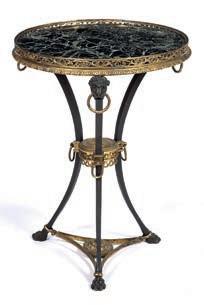
10 Your Letters: A delve into this month’s mailbag reveals memories of a classic car and a meeting with an antiques legend and collector
12 Around the Houses: Possessions owned by the spy writer John le Carré are sold at a UK saleroom as well as a pair of cu inks said to have been made from Cleopatra’s Needle
16 Waxing Lyrical: David Harvey gets write down to it when he puts antique desks in the limelight
29 Subscription O er: Save 33 per cent on the cover price and receive a free book worth £75 when you take out an annual subscription
30 Saleroom Spotlight: Eight photographs by the author Lewis Carroll go under the hammer in Essex
37 An Auctioneer’s Lot: Charles Hanson goes behind the scenes at a Georgian townhouse in Derby, the contents of which are up for sale
Puzzle Pages: Take on the brain of our quiz editor Peter Wade-Wright with his head-scratching quiz and crossword
Top of the Lots: A collection of contemporary Moorcroft pottery is up for sale in Shropshire

56 Book O ers: Make the most of the latest titles from our sister publisher ACC Art Books and save more than a third on the recommended price
58 Auction Calendar: Our up-to-date listings from the UK’s leading auction houses in April

63 Fair News: All the latest about which events are still on and which ones have oundered
64 Fairs Calendar: Check out the events taking place in your region and further a eld around the UK


66 Marc My Words: Step into the world of our resident columnist, the Antiques Roadshow expert Marc Allum
18 e Life of Spry: e amazing career of the orist Constance Spry is put in the spotlight alongside her highly collectable vases
22 All at Sea: A new exhibition on the lives and work of the Dutch-born marine artists the Willem van de Veldes shines a light on a forgotten but highly collectable painting genre
27 Wreck and Roll: Treasures from a 17th-century shipwreck go on show
32 Fashion Icons: e world of textiles and great artists come together in two new exhibitions opening in London this month
38 Pin Your Hopes: Art deco brooches sum up the spirit of the day and are greatly sought after in the saleroom, writes Justin Roberts
44 Bowled Over: Discover why a small Chinese bowl is set to make more than £21m in Hong Kong this month
47 Scandi Style: ink you know Swedish chairs? Discover some surprising mid-century styles which recently sold at auction
50 Venetian Finds: Some 10,000 pieces from one of Venice’s most legendary hotels go under the hammer

Plans for the rst major exhibition in the UK to explore the life and legacy of Saint Francis of Assisi (1181–1226), one of history’s most inspirational and revered gures, have been unveiled for next month.
e National Gallery in London will host the exhibition from May 6 bringing together more than 40 works of art from European and American public and private collections, spanning more than seven centuries, with artists ranging from Caravaggio to Antony Gormley.
In scope they will range from medieval painted panels, to manuscripts, and even a Marvel comic.
A painting by the Uruguayan artist Juan Manuel Blanes (1830-1901) set a record for the artist at a Sussex auction house, becoming the fourth highest auction result for a painting outside London. Toovey’s in Washington hammered the painting Gaucho on Horseback at £1.15m, selling it to a private Uruguayan collector. e sale followed authentication by the ne art consultant Tim Williams after it was previously believed to be of an Argentinian landscape. On seeing the painting Williams spotted the golden glow of Blanes’ palette and his depiction of light on the prairie.

Clothes moth numbers fell by nearly 40 per cent across National Trust houses last year, driven in part by drought and record temperatures, according to the last pest report.
Its author conservator, Hilary Jarvis, said: “This was surprising news. Was it simply too hot – and perhaps more importantly, too dry – for these particular moths to thrive in the warmest year on record?”
Overall, the report found insect pest numbers fell three per cent last year, continuing their decline since the lockdown-driven insect pest boom of 2020. However, many houses recorded high numbers of carpet beetle larvae, which feeds on silk, wool, fur and feathers, while silverfish (Lepisma saccharina) jumped 14 per cent to take the number one slot.
Above left Giovanni di Paolo (d. 1482) Saint Clare Rescuing a Child Mauled by a Wolf, 1455-1460, © e Museum of Fine Arts

Above Antony Gormley (b. 1950) Untitled (for Francis), 1985, © Antony Gormley / photo: Tate

Above right Conservation cleaning in the library at Wimpole, Cambridgeshire, © National Trust Images

Right e Bible could make up to £40m when it is sold at Sotheby’s New York next month
Below Juan Manuel Blanes (1830-1901) Gaucho on Horseback, 1879-1885, sold for £1.15m in Sussex
At more than 1,100 years old, the earliest and most complete Hebrew Bible ever discovered goes under the hammer next month, expected to make $30m-$50m (£25m-£42m).
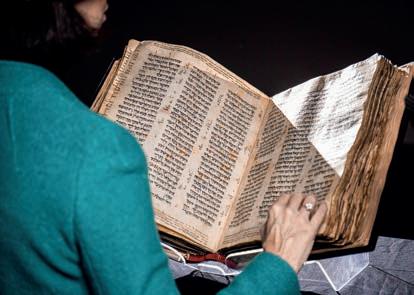
If it does it will be the most valuable historical document or manuscript to appear at auction. The ninth-century volume is a critical link between the Dead Sea scrolls and the Bible of today.
Composed of 24 books divided into three parts – the Pentateuch, the Prophets and the Writings – the Hebrew Bible is the foundation of Judaism and other Abrahamic faiths.
is month’s news sees a decrease in collection-harming pests and a new museum scheme to open exhibitions for all
Animals take centre stage in a new exhibition at the British Library in London this month. Featuring artworks, manuscripts, sound recordings and printed publications, Animals, from April 21 to August 27, explores how humans have documented animals over the past 2,000 years.

Items on display include Robert Hooke’s Micrographia (1665), one of the earliest works on the microscopic world, and John James Audubon’s seminal book e Birds of America (1827-1838), which took more than 10 years to complete and contains 435 life-size watercolours of North American birds. e in uential album Songs of the Humpback Whale (1970), produced by bio-acoustician Roger Payne, is also featured.
Left John James Audubon (1785-1851) Barn Owl from e Birds of America (1827-1838), image courtesy of the British Library

Right Berthe Morisot (1841-1895) Eugène Manet on the Isle of Wight, 1885, © Musée Marmottan Monet, Paris
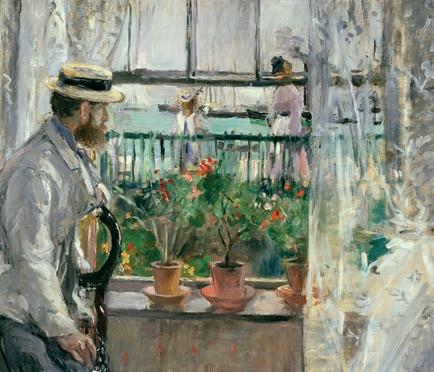
Below right Berthe Morisot (1841-1895) At the Ball, 1875, © Musée Marmottan Monet, Paris
Below far right Berthe Morisot (1841-1895) Self-portrait, 1885, © Musée Marmottan Monet, Paris
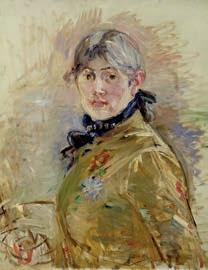
Left Drawings of insects by an unknown Japanese artist, image courtesy of the British Library

Below Chaim Soutine (1894-1943) Le petit patissier, c.1927. Private Collection, © Christie’s Images, Bridgeman Image


Below right Chaim Soutine (1894-1943) Le valet de chambre, c. 1927, the Lewis Collection
An East Sussex gallery this month pairs two major gures of 20th-century painting: one a master of the School of Paris, the other a leading light of the School of London.
e Hastings Contemporary unveils Soutine |Kosso on April 1 – the rst ever museum exhibition to explore the artistic relationship between British artist Leon Kosso (1926-2019) and Belarus-born painter Chaim Soutine (1893-1943).
Soutine moved to Paris as a young man, while Kosso was born and raised in London, his parents having arrived from Ukraine as children. Despite di erent backgrounds, the two artists shared an Eastern European Jewish heritage which united their cultural sensibility.
More than 30 works by the trailblazing French Impressionist, Berthe Morisot (1841-1895) are on display at Dulwich Picture Gallery until September 10.
Berthe Morisot: Shaping Impressionism, is the rst major UK exhibition of the artist who was known for her swiftly painted glimpses of contemporary life and domestic scenes. Morisot featured prominently in the exhibitions by the Impressionists, defying social norms to become one of the movement’s most in uential gures.
Highlights include Eugène Manet on the Isle of Wight (1875), painted while Morisot was on honeymoon in England, and her striking selfportrait (1885).
 Above left Field sketch of a red panda by an unknown artist, image courtesy of the British Library
Above left Field sketch of a red panda by an unknown artist, image courtesy of the British Library

An inaugural exhibition of 20th-century and contemporary art continues at Phillips’ new Asian headquarters in Hong Kong’s West Kowloon Cultural District. One of the auction highlights of the debut sale is a freshto-market painting of a pumpkin by the Japanese painter Yayoi Kusama (b. 1929).

A day-bed made for the wedding of Napoleon Bonaparte and the Empress Marie-Louise in 1810 is one of the treasures going under the hammer next month in Paris.
It comes from the collection of the French interior designer and collector Jacques Garcia (b.1947), who was recently in the limelight when his restored Sicilian villa, Villa Elena in Noto,

Ambitious new plans have been unveiled for the Potteries Museum and Art Gallery, in Stoke-on-Trent, including an extension to the building and the gallery space.


Work to relocate the city’s archive to the site has started, along with a £4.7m revamp of the Spit re Gallery, which houses the Mark XVI WWII Spit re made by locallyborn R. J. Mitchell.
was used in the US series e White Lotus. e project had been a labour of love for Garcia who restored its baroque interiors destroyed in an earthquake in 1693.
e day-bed is one of 75 lots up for sale on May 16 with the proceeds going to another of Garcia’s 30-year restorations, that of the baroque castle, the Château du Champ-de-Bataille in Normandy.
Left e day-bed has an estimate of €100,000€200,000 at Sotheby’s Paris on May 16

There is the opportunity for a behind-the-scenes look at some of Worcestershire’s lesser-known, historic houses this autumn on a new tour.
Participants will stay at Kyre Park, an 18th-century country house set in a Capability Brown park, which is the home of Mrs Tzaraine Gwyn-Jones, whose late husband brought the house back from virtual dereliction.
Historic house expert Nicholas Merchant, will host the four-night break from September 3-7. The trip will also include visits to several neighbouring estates and houses, as well as a trip to the workshop of John Bevan, one of Britain’s foremost cabinetmakers. For full details got to www.aspectevents.co.uk
Russell Cole, watch specialist with the East Anglian auctioneers

Bishop & Miller
How did you start in the business?
Aged 14 I was a Saturday boy and porter at a local auction house, the objects really fascinated me and my career snowballed from there.
Is there a boom in vintage watches?
The market has never really disappeared for a good quality watch. I think people appreciate the engineering that goes into a vintage watch and the fact that they are still operating now as they did
when they were new. I also find that many vintage watches are incredibly stylish and go well with modern fashions.
What has been your greatest find?
It was among a box of old wristwatches I was going through. Underneath them all I found a 1930s Patek Philippe gentleman’s watch. When it was offered at auction it sold for £7,200 to an American collector.

Which watch would you most like to find?
I am a real watch fanatic so I would love to find a Rolex Submariner issued to a Comex oil diver. The dials are marked
with the Comex company name, they are a stunning watch but very rare. My absolute favourite watch has to be a Rolex, more specifically a vintage Rolex Submariner, or even a GMT.
Do you collect? If so, what?
Apart from collecting watches (you can never have enough watches in a collection) I love vintage hi-fi equipment. Who would have thought retro hi-fi would be collectors’ pieces now!
What are your non-antiques hobbies?
I have two small children and we love being outside. I love kayaking and recently tried paddleboarding which I really enjoyed.
Bishop & Miller’s next watch sale is at its Norfolk saleroom, Glandford, on March 29.
e South Korean glass artist Keeryong Choi, who lives and works in Scotland, is among 30 shortlisted artists for this year’s Loewe Foundation craft prize.

e nalists were chosen from more than 2,700 submissions from 117 countries and regions around the world.
e nalists represent 16 countries and work across a range of mediums including
A 12-metre-high sculptural pavilion in the form of a three-tiered wedding cake, by the celebrated Portuguese artist Joana Vasconcelos (b 1971) is set to take centre stage at a Buckinghamshire manor this summer.

Part sculpture, part architectural folly, the piece – clad entirely in 25,150 ceramic tiles – opens at Waddesdon Manor on June 8.
Almost five years in the making, it was commissioned by the Rothschild Foundation, and has been described by the artist as “a temple to love”, celebrating festivity and marriage.
The Wedding Cake stands in a grove of trees alongside the 19th-century dairy. The house manor, built by Baron Ferdinand de Rothschild to entertain
An album signed by 128 recipients of the Victoria Cross, compiled by a “crafty” toastmaster, sold for £4,500 in Derbyshire.
When Jack Masters presided over Victoria Cross centenary celebrations in 1956, attended by Queen Elizabeth II and Prince Philip, he placed his own album alongside that of the monarch.
ceramics, woodwork, textiles, furniture, paper, basketry, glass, metal, jewellery, lacquer, leather and bookbinding.
Choi’s shortlisted glass vessels are inlaid with gold leaf to evoke a starry sky and celebrate the imperfections and beauty of art. e winner will be announced on May 16 in New York.

Above left Keeryong Choi, United Kingdom, Daam Dah 2022, in glass and 23.5ct gold, ©LOEWE
Above Shortlisted Keeryong Choi who lives and works in Scotland, ©LOEWE
North Yorkshire auctioneer Elstob & Elstob has launched specialist sales dedicated to historic and contemporary Asian art forms.
David Elstob, director of the Riponbased auction house, said: “There has been a significant rise in the buying and selling of Asian art, whether ancient or modern.
“At our own auctions, we have seen increased sales and rising prices with bidding not only from the UK, but across Europe and globally.”
The first online sale, which ended on March 5, saw collectors bid on treasures from the Indian and Islamic world, China, Japan, Korea and South-East Asia.

e Sainsbury Centre in Norwich has become the rst museum in the UK to introduce a universal ‘pay what you can’ ticketing system for its exhibitions.
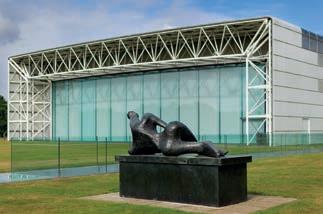
guests at his famous house parties, is celebrated for its ceramics, particularly Sèvres and Meissen porcelain.
While permanent galleries are free, temporary exhibitions can have a price tag of £14.
His son-in-law John Dunkley said: “When the veterans arrived they were asked to sign a book for the Queen. My crafty father-in-law asked them all to sign his book too, meaning the only other VC signatures book like this in the world will be in the Royal Collection.”

Hansons’ militaria consultant, Matt Crowson, said: “As far as we know, no other collection of VC winners’ signatures as comprehensive as this example has ever been o ered for sale.”

e VC, introduced by Queen Victoria in 1856, is given for valour ‘in the presence of the enemy’, it is the highest award of the British honours system.
e centre’s executive director, Jago Cooper, said: “We want more people to visit and enjoy one of the most genredefying art museums in the world. An open and dynamic arts landscape across the whole museum provides a better experience for everyone who visits us.”
From March 12 visitors have been asked to pay only if they can and whatever they want.
Our star letter receives a copy of British Designer Silver by John Andrew and Derek Styles worth £75. Write to us at Antique Collecting, Sandy Lane, Old Martlesham, Woodbridge, Suffolk, IP12 4SD or email magazine@ accartbooks.com

How wonderful to read about your columnist Charles Hanson’s recent barn- nd array of classic cars in the Midlands (An Auctioneer’s Lot, March issue). It brought to mind memories of my grandparents’ farm in the Peak District where we would stay during the summer holidays in the 1970s.
Left Geo had the pleasure of meeting Henry Sandon the 1980s
Above right Charles’ column brought back happy memories of a Triumph Herald

I very much enjoyed the article on longstanding BBC Antiques Roadshow ceramics specialist Henry Sandon (National Treasure, March issue).

I recall seeing the great man during the lming of one of the programme’s valuation days in the early 1980s in Oldham. Despite a chill wind and squally conditions, Henry was the consummate professional and his usual cheery self and obviously enjoyed meeting members of the public.
I presented him with a willow pattern jug that my mother-in-law had given my wife and I. Sadly, the piece was a common item and not particularly valuable, however the experience of meeting Henry was priceless.
Geo Clements by email

How lovely to y the ag for the dorgi in last month’s issue (Hound for Hound, March issue). While I and my fellow dorgi owners know about the royal connection – the breed came about when one of our dearly departed Queen’s corgis had a chance encounter with Princess Margaret’s dachshund Pipkin – few others are aware. Now hopefully, thanks to your article, people are more aware of their delightful genesis.

Gilly Pearson, Hants, by email
Below Our article struck a chord with dorgi owners
My grandfather’s beloved Triumph Herald 948 convertible was stored in one of the barns beneath a heavy tarpaulin. When he passed away in the early 1980s, I was lucky enough to inherit the car, which gave me many years of pleasure during my university days and was much envied by my fellow students. Sarah Gillespie by email
The answers to the quiz on page 42
Q1 (c) Although the machine looked more like a gate-leg table, it spun cotton thread strong enough to be used as warp instead of the traditional flax. Q2 (b) They are all parts of the under-framing of traditional types of farm wagons. Q3 (a) From the less well-known Beeton Book of Garden Management (first published in the early 1860s). They were all suggested shapes of planting beds. Q4 (c) After a while the chemical turned bronze coins green, and silver ones acquired a sort of yellow slime. Q5 (d) They traditionally had three or five wooden hammers in a frame with the central one fixed. The others were used to strike against each other. Q6 (b). Q7 (a), (b) and (d). His works are not necessarily (as some say) of great artistic worth, but are historically important, and inspired American romantic realism. Q8 (a) Also known as The Game of Matrimony. It was very decorative and the board swivelled on a stand. Q9 (b). Q10 (d) Advertised as “Irrisistable!” its Nat West pigs, however, made an appearance in the 1980s. Disney models and shaving mugs with car motifs came into being in the ‘50s.
The phrase demon’s rim can be rearranged to make modernism; the phrase anti poms can be rearranged to make the word stampino, the phrase cow stain can be rearranged to make the word wainscot and lost hotelier can be rearranged to make the word tortoiseshell


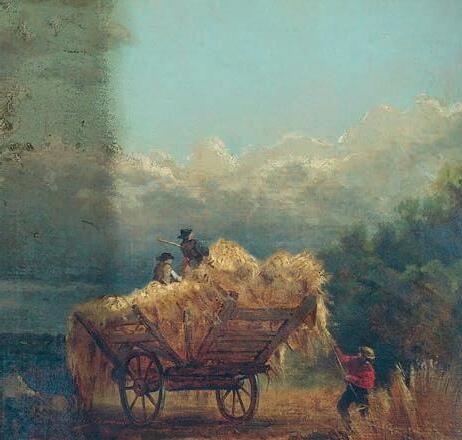
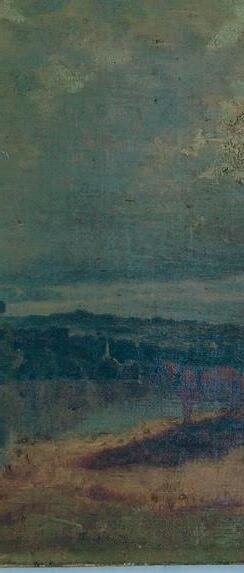
















Chairs proved to be just the ticket at the West Sussex auctioneer’s recent sale when 30 gilt-framed, lattice-back ballroom chairs sold in three lots (each estimated at £150-£250) for a total of £4,300.
At the same sale a set of eight Louis XVI-style gilt-framed dining chairs, with oval-padded backs sold for £1,500, considerably more than its pre-sale guide price of £200-£300. e chairs were among a number of pieces from the stores of Spencer House, the Grade I-listed building in St James’s commissioned in 1756 by John Spencer (who later became the rst Earl Spencer). ey were part of a number of items on display in the State Rooms, or in the o ces and meeting rooms created after extensive renovation of the building in 1985.

A group of 41 English Civil War pamphlets sold for £16,000 at the North Yorkshire auction house’s recent sale, beating its pre-sale guide price of just £400-£600.

e series came from the library of David Stather (19402022), a lawyer and bibliophile whose early interest in history and books was sparked during boyhood trips to Spelman’s, a renowned antiquarian book shop in Micklegate, York.
e English Civil War, between Charles I and Parliament, produced a huge variety of pamphlet and broadsheet literature, with the roughlyprinted texts arguing the issues from both sides.
A striking Louis XVI guéridon fetched more than 20 times top its estimate at the Oxford auctioneer’s recent sale when it sold for £21,000 going to an overseas bidder.
e small, ornate table, featured a circular serpentina verde marble top with pierced ormulu border, and three bronze supports with lion mask ring tops and paw feet.

A gueridon, introduced into France and Italy in the second half of the 17th century, is a small table supported by one or more columns, or sculptural human or mythological gures, often, as in this example, with a circular top.
At the same sale a late 18th to early 19th-century carved elm unicorn, mounted on a lead base and standing 50cm high, which had been expected to fetch £300-£500, hammered at £1,800, this time going to a UK phone bidder.

At the auction house’s March 4 sale a silver and enamel cigarette box by She eld-born Omar Ramsden (1873–1939) and Alwyn Carr (1872-1940) sold mid-estimate for £4,500.

A series of four stick pins commemorating the 80th birthday of Queen Victoria quadrupled its low estimate to sell for £1,600 at the Cotswolds auction house. One of the four pins, marked ‘80’ , was given to Sir Alfred Mordaunt Egerton (18431908) a high-ranking English soldier and courtier Queen Victoria.

The high price achieved reflected the interest in Queen Victoria memorabilia
A butterscotch glass version of the vase Tortues (Tortoise) designed in 1926 by René Lalique (1860-1945) led the Scottish auction house’s recent sale devoted to the French jeweller-turnedglassmaker.
Head of sale, Joy McCall, said: “ e Tortues is scarce and popular in any colour but in butterscotch it was stunning. It is pleasure to handle pieces I have not previously encountered.”
The butterscotch colour is one of the vase’s rarest variants The Lalique perfume bottle achieved a sweet-smelling £10,080 at the same sale


A bronze Elizabeth I Exchequer-standard pint measure, with a low estimate of £8,000, set an auction house record for a measure when it sold for £39,000 at the Suffolk auction house’s specialist oak sale. Dated 1601, the year Elizabeth I issued a series of measures, from bushel to half-pint, to approximately 60 county towns across England to enforce fair trade. e measure sold would have been used by town or city councils to settle disputes by establishing true capacity.

The Elizabeth I pint measure (seen in rotation) set a house record
A Victorian armchair by Gillows, c.1860, once owned by the late David Cornwell (1931-2020), better known by his n name John le Carré, sold for ore than 10 times its high estimate f £300 when it fetched£3,120. At the same sale another of the author’s possessions, this time an 1827 map of London sold for £12,350 against a presale guide price of £3,000-£5,000.
The kelim-upholstered chair was once owned by the spy writer John le

e rst edition map of the capital by Christopher and John Greenwood remains one of the nest maps of the period.

A Victorian mahogany table removed from the royal retiring rooms at Wolferton station near to theSandringham Estate sold for £400 atthe Norfolk auction house’s sale. When Wolferton station closed in 1967 the table was auctionedwith other items from the depot.

A great crowd attended the sale with the headlining lot, which sold for £125, being “A handsome mahogany framed dining table on pedestal legs.”
e table remained in the family which brought it in 1967, with the current vendor inheriting it from her father.

The table took centre stage when the waiting room furniture was auctioned in 1967
The table would have been used by royalty visiting Norfolk’s Sandringham Estate

A conical sugar bowl, designed by the pioneering 19th-century designer Christopher Dresser (18341904), and made around 1885 by Elkington & Co. sold for £43,140 at the auction house’s recent sale, beating its pre-sale estimate of £15,000-£20,000.

But the surprise of the sale was a French table with Dinanderie legs, c. 1935, which smashed it’s guide price of £1,000-£1,500 to sell for £25,500.

Dinanderie is the French term for copper and brass craftsmanship and derives from the present-day Belgian town of Dinant, a noted centre of copper production in the 11th century onwards.
A rare ‘Titanic’ co ee cup and saucer, expected to make £800£1,200 sold for £6,000 at the Sta ordshire auctioneer’s recent sale after attracting bids from all over the world before selling to a collector in America.
e Spode demitasse co ee cup and saucer in cobalt blue and gilt were discovered during a house clearance in the Four Oaks area.

Both were produced around 1911 and were marked ‘White Star Line’. Senior valuer, Sarah Williams, said: “ is opulent pattern is believed to have been used in Titanic’s rst class restaurant but some experts suggest it was produced in such limited numbers that it may only have been used for room service on private promenade suites.”
A pair of granite dress studs, 1.2cm in diameter and allegedly made from Cleopatra’s Needle, sold for £754 at the Midlands auctioneer’s recent sale.

When the Sultan of Egypt and Sudan, Muhammad Ali Pasha, presented the famous Needle to Britain (one of a pair from the ancient city of Heliopolis and dating back to around 1450 BC) it caused a public sensation, with a number of souvenirs of created – including dress studs.
Fellows’ Ben Randall, said: “After fervent bids, one victorious buyer was delighted to purchase these incredible pieces with thousands of years of history and culture.”
The dress studs, with a long history, sparked a bidding war in the Midlands
A diamond and seed pearl brooch in the shape of a shamrock proved lucky for the Kent auctioneers when it de ed its pre-sale estimate of £400-£600 to sell for £2,000. e mid-century piece, which could also be worn as a pendant, had a .50ct diamond at its heart, surrounded by nine seed pearls. It was also o ered for sale in its original box.

e simplicity and symbolism of the shamrock is long established: its three leaves are thought to represent the Father, the Son, and e Holy Ghost. Saint Patrick, one of the three patron saints of Ireland, used the shamrock to illustrate the presence of the Holy Trinity. e shamrock would later become the national symbol of Ireland in 1801 and considered to give luck to its wearer.
The shamrock -shaped brooch proved lucky for some in Kent
The cup and saucer were used by the doomed ship’s wealthiest passengers
The sugar bowl is typical of the designs of Christopher Dresser (1834-1904)The
table’s striking Dinanderie legs proved a hit with bidders



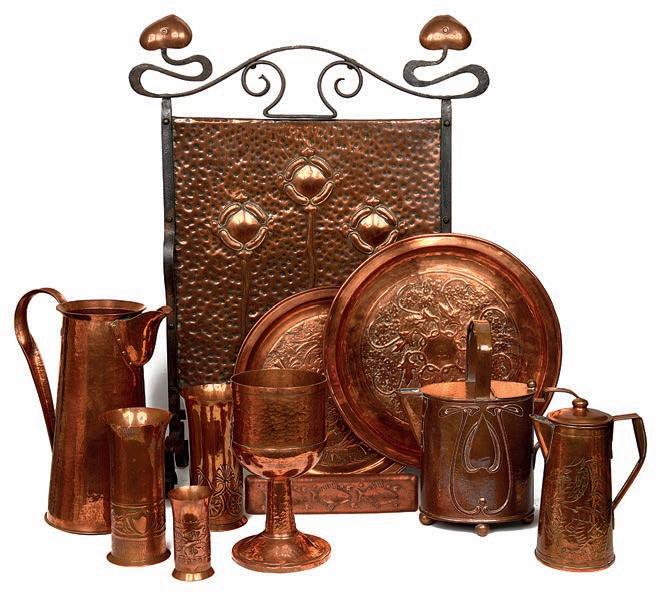


Having just returned to the shop after the Peters eld Antiques Fair, I was struck at the number of pieces of antique writing furniture I currently have in stock. With many people still working from home demand remains high and I thought it could be fun to look at desks through the kaleidoscope of history starting in the late 17th century.
e date of the bureau cabinet above is around 1685.
e fact that it is made in three sections, rather than two, helps date it along with other details, such as the crossgrain mouldings which are on the carcass rather than the edge of the drawers. e feather banding, the bun feet and the shape of the moulded cornice also endorse this date.
e highly- gured walnut veneers are typical of the period and beautifully quartered on the doors, as well as being surrounded by feather banding. As is often the case with bureaux, bookcases and escritoires during this period, there are secret or hidden drawers and compartments within. I am still waiting to nd a hoard of gold sovereigns or diamonds!



From the same period of the late 17th century, I have this delightful oak table top bureau which would have been moved from one table to another in order to get the best light or heat.
ese days, of course, the advent of wi- , laptops and even smaller portable devices means communication can be conducted from almost any room, from the kitchen to an attic. But in the 17th century, all work would have been executed by daylight or candlelight and heating would

As we move towards the end of the 18th century, the interiors of secretaires and bureaux became more elaborate and beautifully inlaid in a variety of woods re ecting the fashions of the time. Ladies were spending increasing amounts of time both reading and writing. e advent of the revolving libraries in towns and the introduction of novels by authors such as Fielding and Sheridan helped to drive this change. So the furniture for all manner of things became both lighter and more elegant to suit the users.
Above e bureau cabinet dates to approximately 1685
Above right e oak table top bureau dates to the late 17th century
Right e interior of desks became more intricate as the 18th century progressed
Left A late 18th-century mahogany bureau

Right A George III mahogany library secretaire desk by Gillows of Lancaster

Below left A Gillows Pembroke table
Below right David’s burr walnut kneehole desk
As the British-Irish author John le Carré wrote: “A desk is a dangerous place from which to view the world.” While we all understand the limitations of experiencing life from the con nes of an o ce, I wonder what sort of a desk he sat at to pen his works.
Could it have been a mid 18th-century mahogany bureau like the one above which would have graced many upper middle-class homes by the 1770s?
is desk belonged to my late father and I confess that I received many a reprimand while he sat here going through my school reports.
Such pieces would have been a standard item of furniture for many and passed down families for centuries. is bureau has the signi cant advantage of a ap which could be closed and locked to hide con dential papers from prying eyes. It also has a good sized working area and, like many, is tted with small drawers and pigeon holes to the interior.

Gillows of Lancaster produced a series of intricate secretaire cabinets for a gentleman’s library. They are mostly free standing and finished all the way around to stand in the centre of the room.
Having returned from the Grand Tour with a multiplicity of books, pictures, artefacts, mosaics and works of art, one would want a piece like this to sit at and catalogue one’s acquisitions and impress one’s peer group.
I write this article from the wonderful burr walnut kneehole desk below, dating from the reign of George I in about 1720. e cross-grain mouldings have disappeared altogether, replaced by a moulded edge to the drawers. e fashion for bun feet has also given way to shaped bracket feet re ecting the shaping of the apron above the kneehole. It is wonderful to think of all the others who have sat at the same desk down the years writing everything from legal documents to love letters, and perhaps even the odd article.
As we move into the Regency period, the need to be able to write in many di erent rooms became even greater. is would also have been a result of improving education as more people became literate and society moved from being largely agricultural to more industrial and increasingly urban.
is very good mahogany Pembroke table above has a typical Gillows-type of reeded leg.


e di erence is that this example has a drawer at one end which is tted for reading and writing at. It dates from about 1815 and is a delight to see.

‘The desk belonged to my late father and I confess that I received many a reprimand while he sat there going through my school reports’David Harvey is the owner of Witney-based W R Harvey & Co. (Antiques) Ltd. For more details go to the website www.wrharvey.com
Long



as

Twenty years ago, bar a few collectors, vases designed by the society orist Constance Spry (1886-1960) and the Fulham Pottery were the stu of charity shops. Spry might very well have turned the art of ower arranging on its head but, in the years since her height, the mantle vases she designed to house her outré displays were seen as drab and dated.
But their popularity has soared in the last 10 years as fashions in interiors have changed. In 2021, the Garden Museum staged an exhibition of her vases, with their muted colour palate proving a hit everywhere from design magazines to Instagram.
Above Flowers in a Fulham Pottery tulip vase, designed by Gerard de Witt (1884-1976), 35cm wide and 30cm high. e vase has an estimate of £250-£350 in this month’s sale

Above right Studio portrait of Constance Spry (1886-1960) probably taken c.1905, image credit RHS Lindley Collections

Above far right A display of wax and wired owers by Constance Spry in a case, image credit RHS Lindley Collections.
Right A small, glazed Fulham Pottery vase in the shape of an urn, with the Fulham Pottery marks on the underside. 16.5cm high, estimated at £80-£120
It was the exhibition at the Garden Museum which made Julie Sumner, the owner of the collection which goes under the hammer at Catherine Southon’s sale on April 26, fall in love with the style. She said: “I had a few Constance Spry vases but after visiting the exhibition and seeing how wonderful they look together, I began hunting out more Fulham pottery vases.
“ ey are incredibly curvaceous, and the unglazed ones are so tactile. e designs are wonderful to arrange owers in, or even plant up with spring bulbs or plants. ey also look great in a modern minimalist setting. Beware though – collecting these vases does become very addictive.”
Catherine Southon said of the sale: “With estimates starting at £60 (going up to £2,500 for a vase designed by Constance Spry herself) it is a wonderful opportunity to start, or add to, a collection.”
For collectors, the Constance Spry vase not only revolutionised the fortunes of the Fulham Pottery (who made her vases) but was also a major factor in the mass popularisation of ower arranging in the years following the war.


condemned
‘granny ware’, vases by Constance Spry and the Fulham Pottery are back in vogue. With a collection going under the hammer at Catherine Southon Auctioneers this month in Surrey, Hans Pugh takes up the story
hops and brambles, Spry, changed 20th-century attitudes to ower arranging. But despite her in uence, her success came late in life – she only started ower arranging at the age of 41 – and the celebrity circles in which she mixed were a far cry from her early life.
Her life story is both surprising and surprisingly modern. From the poverty of the Victorian north, she escaped a violent marriage and, unusually for her time, set up her own successful business. In middle age she also fell in love with the artist Hannah Gluckstein, known as Gluck, and enjoyed a happy same-sex relationship for many years.
Born into a working-class Derby family in 1886, the family moved to Dublin in 1902 where Spry went on to study nursing and physiology at Alexandra College in the city.
In 1936, Spry and her team collaborated with the stage designer and artist Oliver Messel to produce a crown and lion vase and a long deep planter for Edward VIII’s coronation. On his abdication, rather than abandon the designs they were used for the coronation of his brother George VI.
In the same year Spry was commissioned to design the flowers for the wedding of the Duke of Gloucester to Lady Alice Montagu-Douglas-Scott.
Hat vase designed by Constance Spry (18861960) for the Fulham Pottery, glazed on the inside with the underside stamped ‘Designed by Constance Fry’, facsimile signature, and ‘Made in England’, and inscribed, ‘155’. 44cm wide and 20.5cm high, it is estimated to make £1,500-£2,500
Below left A small Fulham Pottery glazed vase of ribbed, tapered and bellied form, marked on the underside with Fulham Pottery stamp, ‘Made in England’ and the initials, ‘BB’. 10.5cm high, estimated at £40£60

Below right A collection of vases by Constance Spry and the Fulham Pottery goes on sale this month


A year later she was called on as the florist for the private wedding of the Duke of Windsor to Wallis Simpson in 1937.
In the 1953 coronation of Elizabeth II Spry designed the vases and floral displays at Westminster and along the route to Buckingham Palace. One of her coronation vases sold last year for £10,000.
After a stint in London, she returned to Dublin in 1908 to lecture in rst aid and home care for the Irish Women’s National Health Association. A year later, aged 23, she met a mine manager called James Heppell Marr, and seven months later married him.
e couple had a son, but were not happy, and when war broke out in 1914, and Marr enlisted, Spry moved rst to Dublin to set up a branch of the Red Cross, and then to London, where she was ultimately promoted to director of women sta at the Ministry of Munitions. It was here she met its chief establishment o cer, Henry Ernest Spry with whom she set up home and took his name.
In 1921, Spry was appointed headmistress of the Homerton and South Hackney Day Continuation School which taught cooking, household budgeting, dressmaking and ower arranging to young women from the East End of London.
In 1926, Constance and Henry moved to Abinger Rectory in Reigate, Surrey. Always a keen gardener Spry started to create ower arrangements for friends. Rather than
‘Rather than unobtrusive vases of flowers, Spry’s style favoured large displays that made a central feature often making use of overlooked plants. Untrained in floristry her approach was unconstrained and original’
Left An unglazed Fulham Pottery vase, glazed on the inside, with the ‘ e Pottery Fulham London, Made in England’ stamped on the underside and initialled ‘CWA2’. 16cm high, 12cm wide, estimated to make £100-£150
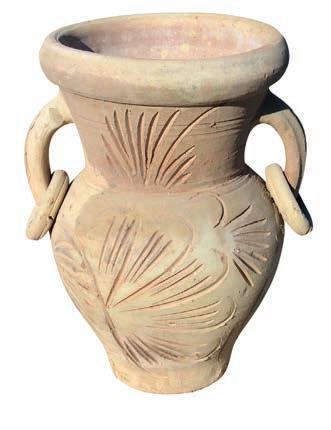

Below Spry was inspired by the purity and balance of Tunisian pots, image Shutterstock
Below left Gluck (18951978) Flora’s Cloak, c. 1923, image courtesy of Sotheby’s

Prior to the late ‘20s and early 30s the prevalent interiors trend had been full of colour – part inspired by a fashion for all things Egyptian following Howard Carter’s discovery of Tutankhamun in 1922 – and part by the bold designs and colours of Diaghilev’s Ballets Russes which ltered through to theatre, fashion and interior design.
But by the late ‘20s there was a fashion for all white. As Sue Shephard writes in her book e Surprising Life of Constance Spry: “Everything was white: white décor, white clothes and white owers. e all-white ‘Baroque’ style, know as regency Vogue swept through both the houses and the theatres.”
All white parties became the height of fashion with many commissioning Spry with the oral decorations.
unobtrusive vases of owers, Spry’s style favoured large displays that made a central feature often making use of overlooked plants.
Untrained in oristry her approach was unconstrained and original. In 1927, the show business entrepreneur Sidney Bernstein, bored by conventional bouquets, commissioned her to provide owers for his cinema chain Granada. Her style soon became better known, with the designer Norman Wilkinson persuading her to create oral displays for a perfumery shop on Bond Street that he was redesigning. It was a display which e ectively launched her career.
With such high-pro le commissions Spry’s owers soon became the toast of the London social scene of the inter-war years. So much so, in 1928 she gave up teaching and a year later, aged 43, opened her rst shop, Flower Decorations in Belgrave Road in Pimlico, to distinguish it from the run-of-the-mill arrangements supplied by orists. Greater success soon followed and, by 1934 she had cut the ribbon on a new shop at 64 South Audley Street, Mayfair and was employing 70 people.
Below right A twinhandled Fulham Pottery glazed vase, designed by William John Marriner (1881-1967), inspired by Constance Spry, stamped, ‘ e Pottery Fulham London Made in England’ on the underside. 42cm side, 19cm high, estimated to make £250-£350
In 1932, Spry was commissioned to create a display for the studio opening of the cross-dressing Hannah Gluckstein, who from the age of 23, had adopted a non-gender specific name of Gluck, wore men’s clothing, cropped her hair and started smoking a pipe.
The unlikely couple (Spry was in middle age when they met) embarked on a four-year affair during which Gluck immortalised her arrangements in still-lifes, with Gluck presenting her with Flora’s Cloak which hung in Spry’s shop and her home and was known affectionately by her staff as ‘interflora’.
During her career, Spry seemed to give very little thought to the vases that she designed. ere are few references to them in her letters or biographies—she appeared to view them simply as vessels to display her art.
Many of the vases came from bric-a-brac shops or ransacking attics. However, practicality was an issue; her arrangements required wide-mouthed bowls which could t on mantles. One of her sta , Florence Standfast, who Spry had known since her student days in London, was already responsible for making arti cial owers to sell in

The couple shared a love of nature and travel and on a holiday in Africa Spry may have found inspiration for her vases. Sue Shephard writes: “Connie who had already begun making her own pots, derived inspiration from antique pots she found in Tunisia. She searched through the museums in Tunis asking Gluck to sketch Roman, Greek and Phoenician pieces for her. Connnie described their characteristic ‘purity of outline and perfections of balance’.”
she then hand-painted and dipped in hot wax.
e rst vases were handmade in papier-mâché and coated in varnish or plaster. But when the requirement for a regular supply of commercially viable vases became evident, Spry approached nearby Fulham Pottery.
At the time the pottery, known for its large-scale manufacture of early salt-glazed stoneware, was in the doldrums. In the ‘30s, after a number of attempts to reintroduce ‘art’ pottery had oundered, the rm was in desperate need of a new direction.
In 1935, the Fulham Pottery was engaged to create a range, producing Standfast’s outsized, classically-inspired designs in a Devonshire earthenware.
e pottery employed press-moulding techniques to make the range. Typically, they were only biscuit red (Spry liked the plaster-like nish that could be painted if desired) with a glaze only applied internally to make the vessels watertight.
Spry encouraged customers to paint the vases to match their interiors, in her 1951 book Summer & Autumn Flowers, she wrote: “Egg-shell blue, a dusty pink and soft lime-green are three colours that meet with general approval and look well.”
e vases were designed to melt into the background and to let the owers do the talking. ey are in neutral colours with no patterns, with the black examples intended to work with brighter and stronger coloured owers. Deceptively simple in design, they were mostly symmetrical with undulating lines and with a Grecian, even art deco avour to them.



Bearing an impressed facsimile signature, they were retailed by Flower Decorations Ltd and remained in production into the mid 1950s.
with loop handles designed by Constance Spry (1886-1960) for the Fulham Pottery, glazed on the inside with the underside stamped, ‘Designed by Constance Spry Flower Decorations Ltd’. 48cm wide and 20cm high, estimated to make £400-£600
Right A pair of Fulham Pottery lotus vases, probably designed by Charles West, with the underside marked for Fulham Pottery. 30cm wide and 15cm high, estimated at £120-£180
Below left A glazed, scallop-shaped Fulham Pottery vase, designed by William John Marriner (1881-1967), inspired by Constance Spry with the Fulham Pottery mark stamped on the underside. 44cm wide, 14cm high, estimated to make £300-£500
So popular were Spry’s designs for Fulham Pottery that it began to make its own range.
Unglazed and known as Alber Ware and Coralie, they echoed Spry’s fondness for a muted colour that wouldn’t detract from the beauty of the flowers themselves.
When it comes to collecting it is the vases designed and signed by Constance Spry that are the more collectable and valuable. This month’s sale includes two from the collection (left).
Of these it is generally Spry’s earlier, unglazed examples which are most sought after and can run to several thousands of pounds.
Fulham Pottery’s own ranges are also sought after making on average £200-£400. Much of Fulham Pottery’s Alber Ware range was designed by William John Marriner (1881-1967). One of the most popular vases in the range, designed by Marriner in 1937, was neoclassical shape, with swan neck handles. It was called ‘FMA’. F standing for Fulham, M for Marriner, A for the pattern and 2 for the larger size.
Gerard de Witt’s (1884-1976) designs for Fulham Pottery in the late 1930s and ‘40s are also collectable. His name is usually stamped to the base. Pale green as a colour option was introduced in 1954.
At the start of WWII, Spry resumed her teaching career encouraging women to grow, cook and eat their own food. In 1946 she and her friend Rosemary Hume opened the Residential School of Cooking, Gardening and Home Decoration at Wink eld Place in Berkshire.
Together they famously helped to co-invent coronation chicken when they were involved in preparing the food for the coronation banquet – as well as the owers.
Spry was awarded an OBE in 1953 and died in 1960 after a fall. Today there is a blue plaque on the site of her second shop and the world- renowned rose grower, the late David Austin, named his rst ever rose, the ‘Constance Spry’ rose.
A collection of Constance Spry and Fulham Pottery vases is part of Catherine Southon’s sale on April 26 at Farleigh Court Golf Club, Old Farleigh Road, Selsdon, Surrey, CR6 9PE. For more details go to www.catherinesouthon.co.uk
Marine painting as an independent genre evolved slowly, after religious, historical, portrait and landscape art. In the 16th century it was mostly linked to biblical stories and parables such as Jonah and the Whale.

e Renaissance brought northern Europe a growing freedom to paint new subjects and the development of new skills – especially in the three-dimensional perspective which permitted the portrayal of objects with greater realism on the two dimensional surface such as panel or canvas.
Marine painting also bene ted from the development of navigational charts pioneered in southern Europe during the 13th century.
e foundation of the Dutch East India Company in 1602 and the subsequent overseas trade with India and China brought new wealth. By the mid 17th century Holland possessed many painters of superlative talent
350 years after the Willem van de Veldes – considered the founders of English marine art – arrived in London, Antique Collecting shines a light on the genre
catering for the growing demand for marine subjects from the burgeoning number of rich merchants whose income was derived from the sea.
Hendrik Cornelisz Vroom (1566-1640) pioneered many of the subject categories of maritime art, including naval battles and everyday marine views of small craft.
But it was left to his followers, notably the Willem van de Veldes – on whom a new exhibition at the Queen’s House in Greenwich is based – to develop representational techniques.
Willem van de Veldes


e Willem van de Veldes, a father and son, generally refered to as the Elder (1611-1693) and the Younger (16331707) were born in Leiden and are generally considered to be two of the nest marine artists of all time.
ey worked individually and in partnership, the Elder providing sketches and drawings, often annotated for his son to work up and nish as oil painting.
e family arrived in Amsterdam in 1633 living in the harbour area near Montelbaanstoren where the Elder observed and recorded shipping and other aspects of maritime life. After a brief career at sea, he decided to become an artist.
His ability as a draughtsman allowed him to develop a unique style known as penschildering, or pen painting. e ends of the lines were pointed to resemble their engraved equivalent. Although it took months rather than weeks to complete a picture, greater detail and overall
Left Willem van de Velde the Younger, (1633-1707) e ‘Resolution’ in a Gale. e Resolution was one of the rst of the 70-gun two-deckers, built at Harwich in 1667 and rebuilt in 1698, © National Maritime Museum

Below right e Burning of the Royal James at the Battle of Solebay, 28 May 1672, © National Maritime Museum
Below Willem van de Velde the Elder (16111693), Ships Draughtsman to King Charles II by Sir Godfrey Kneller (16461723) print by Gerard Sibelius, © National Maritime Museum, London
In addition to painting, early marine artists designed tapestries. During the first half of the 17th century tapestries were more highly prized than paintings and fortunes were spent on them. A series of 10 tapestries of the Spanish Armada by Cornelisz Vroom cost Lord Howard of Effingham £1,582 in 1592 - a fortune at the time. This month’s exhibition in Greenwich includes the tapestry The Burning of the Royal James at the Battle of Solebay, 28 May 1672, otherwise known as The Solebay Tapestry.
Originally part of a set of six, it was based on original cartoons of the battle designed by Van de Velde the Elder.
This tapestry depicts the climax of the battle off the Suffolk coast: the destruction of the English flagship Royal James.

Above Willem van de Velde the Younger (16331707) by Sir Godfrey Kneller (1646-1723) print by John Smith, © National Maritime Museum, London
Right Willem van de Velde the Elder (16111693) A Dutch Bezan Yacht and many other Vessels in a Crowded Harbour beside a Tavern. It demonstrates his pen painting technique allowing him to achieve exquisite detail, © National Maritime Museum, London

clarity were possible.
Willem van de Velde the Younger worked in oils, often using his father’s extraordinarily detailed drawings as source material. He trained with Simon de Vlieger (c. 1600-1653) going on to create dramatic, atmospheric paintings, particularly the stormscapes that appealed to an English market.
Such works established his reputation as one of the leading marine painters of the 17th century and reportedly led JMW Turner to declare, “this made me a painter.”
‘Willem van de Velde the Elder’s ability as a draughtsman allowed him to develop a unique style known as penschildering or pen painting’
Left Willem van de Velde the Younger (1633-1707) e Royal Escape Close-Hauled in a Breeze. e Royal Escape was a coasting collier on which Charles II escaped to France after his defeat by Cromwell at Worcester in September 1651 © National Maritime Museum, London
With the unrest following Louis XIV’s invasion of Holland, making artistic patrons rare (and the break down of the Elder’s marriage) the van de Veldes moved to London in 1673 settling initially in Greenwich.
As such they were heeding Charles II’s invitation for Dutch artists to settle in the UK and, hopeful of new patrons, they emigrated. e van de Veldes’ skills were appreciated in England by a wide circle of patrons, including the king and his brother James, the Duke of York. e Duke and Duchess of Lauderdale commissioned
The epic skirmish off the coast of the Suffolk town Southwold, was the opening battle of the third Anglo-Dutch War, 1672-1674.
With 75 wars ships, 20,738 men and 4,484 cannons, the Ducth forces surprised the joint Anglo-French fleet of 85-95 warships and 34,496 men. Admiral Edward Montagu, 1st Earl of Sandwich, in the ‘Royal James’ was able to sink two Dutch fireships, but a third set her ablaze.
Amid the flames Sandwich tried to escape by boat, but it was swamped fleeing seamen and he drowned. The Dutch were driven off leaving the allied fleet so damaged that it was impossible to attempt the projected landing in Holland. Both sides claimed victory. The battle was captured by van de Velde the Younger.
the van de Veldes to redecorate Ham House in Richmond.
Charles II was soon eager to retain their services and in 1674 they signed a contract whereby the Treasurer of the Navy was ordered to pay “the salary of One hundred pounds per annum undo Willem Vanderveld the elder for taking and making Draughts of Sea Fights and the Like Salary of One Hundred pounds per annum unto William Vanderveld the younger for putting the said Draughts into Colour (oils) for Our particular use.”
e king provided studio space for the van de Veldes in the Queen’s House at Greenwich (the location of this month’s exhibition and now part of the National Maritime Museum). One of the earliest commissions was to provide high horizon drawings and later paintings of the third Anglo-Dutch War, including the battle of Solebay, to be used by the tapestry makers in Mortlake, west London.
Above Willem van de Velde the Younger (16331707) e Departure of William of Orange and Princess Mary for Holland, November 1677, © National Maritime Museum, London
Below left Willem van de Velde the Younger (16331707) e Burning of the ‘Royal James’ at the Battle of Solebay, 28 May 1872, © National Maritime Museum, London
From their Queen’s House studio, their home for 20 years, the van de Veldes revolutionised marine painting in Britain and established a genre that persists today. By 1675 it was an active painting studio where Dutch and English studio assistants learned new skills and many became professional painters.
Works often included eye-witness depictions of dramatic naval battles and momentous historical events. Both artists witnessed Charles II travelling to Scheveningen, en route to England for the Restoration in 1660, and both depicted William of Orange departing England with his bride, Mary Stuart (later William III and Mary II) in November 1677 for their honeymoon in the Netherlands. e picture shows the yachts and their escort



‘Works often included eye-witness depictions of dramatic naval battles and momentous historical events. Both artists witnessed Charles II travelling to Scheveningen, en route to England for the Restoration in 1660’
preparing to get under way. e most prominent vessel is the ‘Mary’ a smack-rigged royal yacht on which the prince is recognisable because he is wearing a hat.
One of their most important works is A Royal Visit to the Fleet. During the summer of 1672, Charles II visited ships of the eet that were being re tted on the ames following the Battle of Solebay. e painting is a busy scene of yachts and boats moving towards the ‘Prince’ in response to the signal of a royal standard in the mizzen shrouds, calling a council-of-war of all ag o cers. It was worked on in the van de Veldes’ studio at the Queen’s House in the 1670s and, at almost 4m across, was the largest seascape van de Velde the Younger had painted. e scale of the painting coupled with a low viewpoint lends it a dramatic, panoramic quality. e commanding painting shows why the legacy of the van de Veldes helped de ne English marine painting for the next two hundred years.


e Van de Veldes: Greenwich, Art and the Sea is on at e Queen’s House, Greenwich, until January 24, 2024. For more details visit www.rmg.co.uk/van-de-velde
Right Peter Monamy (1681-1749) Harbour Scene: An English Ship with Sails Loosened Firing a Gun, oil on canvas, image courtesy of the Metropolitan Museum of Art (not in exhibition)

Left Willem van de Velde the Younger (1633-1707)
Charles II’s visit to the Combined French and English Fleets at the Nore, 6 June 1672, © National Maritime Museum, London
Below left Willem van de Velde the Elder (16111693) e embarkation of William of Orange and Princess Mary at Margate in November 1677 on their return to Holland after their marriage, © National Maritime Museum, London
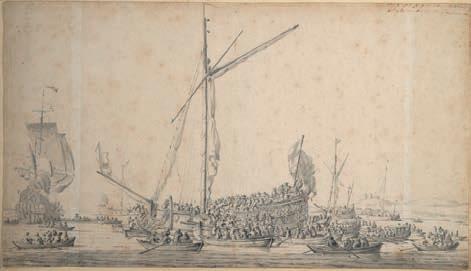
Below Willem Van de Velde the Younger (16331707) A Royal Visit to the Fleet in the ames Estuary, 1672, © National Maritime Museum, London


Peter Monamy (1681-1749)
An early professional English marine painter and one of the most gifted European marine painters of the first half of the 18th century.
Monamy cleverly described himself on his printed trade card as “second only to van de Velde” cashing in on the reputation of the Dutch artists. He was born in London between 1696 and 1704 and was apprenticed to William Clarke, of the Painter-Stainers Company who, according to Horace Walpole, was a sign and house painter living on London Bridge. Monamy excelled in a wide variety of marine subjects including merchant vessels, portraits of yachts and sea battles.
James Edward Buttersworth (1817-1894)
Buttersworth was an English marine painter who moved to America around 1845 and set up his own studio in Brooklyn. He is best known for his scenes of sailing competitions, such as the dynamic Trials for Contenders for America’s Cup Defense (1893), as well as shipping scenes and boat portraits.
William Lionel Wyllie (1851-1931)
A leading English marine painter, Wyllie won the Turner Gold Medal aged just 18 before earning full membership to London’s Royal Academy of Art. Wyllie was closely tied to the Royal Navy and lived in Portsmouth, where he was marine painter to the Royal Yacht Squadron and the Royal Victoria Yacht Club.
Charles Edward Dixon (1872 -1934)
Son of the historical painter Alfred Dixon, Charles started exhibiting at the Royal Academy at just 16 years old. He is best known for his well-observed views of the Thames.
Montague Dawson (1895-1973)
Dawson served in the Royal Navy during World War I and again in World War II as a war artist. His works often focus on historical subjects, with riveting depictions of ships in highly dramatic seas. Dawson is considered by many the leading marine artist of the 20th century.
We asked Rhyanon Demery, head of marine art at Bonhams, the only international auction house to hold dedicated sales to the category, about the current market

(1942-2021). Dawson’s abilities to capture the speed and excitement of sailing are highly prized among collectors. Another artist whose work I admire is the Plymouth maritime artist Nicholas Matthew Condy (1818-1851). I love the quality of his work, in particular the detail of the central boat or ship and the gures onboard.

De nitely. Our sale last October included many great works fetching around the £1,000-£2,000-mark. Always look for quality, composition, condition and whether it’s a good example of the artist’s work.
Marine watercolours are currently under appreciated and it is still possible to pick up some really lovely works for reasonable sums.
Two such artists whose work is worth considering are John Cantiloe Joy (1806-1859) and his brother William Joy (1803-1865) from the Norwich School of painters. Known collectively as the ‘brothers Joy’, they attended Mr Wright’s Southtown Academy in Great Yarmouth before moving to London in 1830, receiving commissions from naval patrons. Both are among my favourite marine artists and painted stunning watercolours which don’t fetch as much they used to.
e best way to approach collecting marine art is through careful research. Talk to specialists on the subject or visit museums that hold extensive collections and archives of marine art. Notable British institutions include the National Maritime Museum in Greenwich and Liverpool’s Maritime Museum.
Although the market seems quite niche, you’ll nd marine paintings o ered in general picture sales at regional auction houses throughout the country and, it just so happens, last October we held our most successful sale in the last 40 years. e sale featured the best of the best and appealed to a very established clientele, especially from the UK and America. e market is steady and good but, in saying that, certain artists’ works were achieving better prices 20 years ago – but that’s market trends for you.
Our recent sale included several nice collections, two of which were exceptional. One was a collection belonging to the late Jonathan Janson from the Isle of Wight, which included 58 lots that covered a broad selection of marine paintings from the 18th to 20th century.
Leading the sale were six oil paintings by Montague Dawson (1980-1973) one of the leading marine artists of the 20th century from the collection of the founder of the Williams Formula One team, Sir Frank Williams
Above Montague Dawson (1890-1973)

On the High Seas, oil on canvas, expected to make £60,000-£80,000, it sold for £126,300 at Bonhams’ sale last October

Right Nicholas Matthew Condy (1818-1851) Two big schooners of the Royal Yacht Squadron racing o the Needles, sold for £11,475 at the same sale

Below right John Brett, ARA (1831-1902) Welsh Coast, dated 21 July 91, sold for £2,550 at the same sale
Also look out for coastal scenes, a type of painting that rose in popularity along with the Romantic and Impressionist movements. I really enjoy the work of John Brett (1831-1902), a student of John Ruskin, who is particularly good.
Bonhams’ next marine auction is at its Knightsbridge saleroom on April 26.
‘Marine watercolours are currently under appreciated and it is still possible to pick up some really lovely works for reasonable sums. Two such artists whose work is worth considering are John Cantiloe Joy (1806-1859) and his brother William Joy (1803-1865) from the Norwich School of painters’
Nothing excites collectors like treasure from a shipwreck. Artefacts from a warship described as the “Norfolk Mary Rose” are on show this month
Some 15 years after it was rst discovered, a trove of treasures from the HMS Gloucester have gone on display in Norwich. e warship sank o the coast of Great Yarmouth in 1682 with the loss of 130 lives people. Its wreck, found complete with well-preserved wine jugs, bottles, a ship’s bell and even spectacles, has been hailed as Britain’s most important maritime nd since the Mary Rose.
e wreck was also remarkable because of one of its most high-pro le passengers: James Stuart, Duke of York, who escaped the sinking vessel with moments to spare, and who, three years later, succeeded his brother Charles II, reigning in England and Ireland as James II, and in Scotland as James VII.

Above Johan Danckerts (1615–1686) e Wreck of the Gloucester o Yarmouth, 6 May 1682 e artist was a Dutchborn painter who came to England where his brother, Hendrick, became court painter to Charles II
Below left Selection of glass bottles, ©Norfolk Museums Service, Norfolk Historic Shipwrecks Ltd

During the era’s wars with the Dutch, James was Lord High Admiral of the Fleet and played an active role in the great sea battles, including the Battle of Solebay in 1672.
At the time of Gloucester’s voyage James was travelling back to Scotland in order to take his pregnant wife, Mary of Modena, to the court of Charles II in London. By being born in England the royal family hoped that the child would be a prince to further secure the Stuart dynasty. By 1682 Charles was visibly ageing and power was gravitating to James and a number of prominent English, Irish and Scottish courtiers who accompanied him on the voyage.
Because of her regal passenger, the importance of the Gloucester, for its snapshot of life aboard a royal vessel, cannot be overestimated.
e Duke of York was known to travel with a large retinue of servants, guards and even pet dogs. His household records from after the wreck indicate that he lost many of his servants in the tragedy. On May 8, 1682, Samuel Pepys (who witnessed the wreck) wrote of his delight that James had survived but that there was “a
‘A high proportion of finds relate to eating and drinking. The handle of one spoon, called a “trefid” has two notches at the top, creating a three-lobed outline. It was a short-lived fashion that first appeared at the time of the Restoration in 1660 and remained popular into the early years of the 1700s’
Above Glass urine ask, © Norfolk Museums Service, Norfolk Historic Shipwrecks Ltd
Left Two “Bartmann” jugs, or Bellarmines, ©Norfolk Museums Service, Norfolk Historic Shipwrecks Ltd
Below left Spectacles, © Norfolk Museums Service, Norfolk Historic Shipwrecks Ltd

Below right Leather pouch with symbols of St Edward’s crown, © Norfolk Museums Service, Norfolk Historic Shipwrecks Ltd
greater loss in his train than we can yet make any just computation of.”
e sense of riotous celebration on board is also apparent from the number of wine bottles, glasses, tobacco pipes and beer jugs recovered. e latter, made in salt-glazed stoneware, featuring the motif of a bearded man, are called “Bartmann” jugs (German for “bearded man”) or “Bellarmines” after Cardinal Bellarmine who it was said to resemble. Made in Germany there would probably have been a great many on board.

A high proportion of nds relate to eating and drinking, including bowls made of wood, ne wine glasses, and several spoons made of pewter.
One spoon, called a “tre d” refers to the distinctive shape at the top of the handle, which has two small notches creating a three-lobed outline. is style of spoon was quite a short-lived fashion that rst appeared at the time of the Restoration of the monarchy in 1660 and remained popular into the early years of the 1700s.
Records show three medical professionals on board the Gloucester: James’s personal physician, Sir Charles Scarburgh; the ship’s own surgeon, John Jones, who was part of the crew; and James Livingstone, personal physician to Sir David Falconer, a senior Scottish judge.
A distinctively-shaped glass urine ask, found in 2018, would have been an essential part of 17th-century physicians’ equipment to assess patient health. e one recovered from its wartery grave may well have been used to assess the future king’s urine.

A number of trumpeters would also have been on board, their role being to perform at ceremonial occasions including what would have been the royal progress into Edinburgh after disembarking at the port of Leith.
Royal trumpets were made of silver. As mouthpieces were retractable and spares were often required, the mouthpiece recovered was made of brass. If the trumpet belonged to one of the ship’s crew (a role often taken up by the petty o cer) then the entire instrument would have been made of brass not silver. Another fascinating insight into 17th-century voyages.

e Last Voyage of the Gloucester: Norfolk’s Royal Shipwreck, 1682, runs until September 10 at Norwich Castle Museum and Art Gallery, Norwich, NR1 3JU. A number of events linked to the exhibition will take place in upcoming months including a talk titled Music, Drinking and Other Intoxicants in Restoration England on April 25, for more details go to www.uea.ac.uk
A leather pouch imprinted with five crowns was recovered from a wooden chest from the Gloucester and may have been used to contain papers or promissory notes. The crown depicted is that of St Edward’s, which was made in 1661 for the coronation of Charles II, replacing the lost medieval crown melted down by Parliamentarians in 1649. It is still in use today and will feature in the coronation of Charles III in May.





































age four until just before her 16th birthday. He also photographed her brothers Hugh and Brooke Kitchin.
As well as a writer, with his masterpiece Alice’s Adventures in Wonderland published in 1865, Carroll was a dedicated amateur photographer with a studio in his rooms at Oxford, where he was a mathematics lecturer.

His subjects included self-portraits and portraits of famous artists of the era like Dante Gabriel Rossetti. Of the approximately 3,000 photographs he took, just over half are of children. Many were of Lorina Liddell, the elder sister of Alice Liddell, the girl who inspired the famous Alice character. Xie Kitchen was the daughter of Rev. George William Kitchen (1827-1912), one of Carroll’s colleagues at Christ Church College, Oxford.
In fact Carroll found no shortage of friends who wanted him to make likenesses of their children. In a biography of his uncle, Carroll’s nephew Stuart Collingwood referred to them as his “child friends”.
Later authors painted Carroll, who never married, as a more sinister gure, although no hard evidence has emerged to support it. Whatever the truth there is no doubt images of naked children, which appeared on cards and postcards of the day, were viewed very di erently in Victorian times from today. Naked children were considered worthy art studies, as they were in the work of Dodgson’s contemporary Julia Margaret Cameron.






Although viewed through today’s lens as slightly suspicious, a series of photographs taken by Victorian author Lewis Carroll (1832-1898) of one of his ‘child friends’ goes under the hammer in Essex this month, each with a pre-sale estimate of £1,000.


Attributed to Carroll’s real name, Charles Lutwidge Dodgson, the eight images were discovered in the back of a safe in a Hertfordshire farmhouse. ey are o ered for sale in a timed auction at Sworders, Stansted Mount tchet, this month from April 14-23. e subject in all is the same girl, Alexandra ‘Xie’ Rhoda Kitchen (1864-1925) and all were consigned by the Rev George Kitchen’s great grandchildren.
Xie was a favourite photographic subject of Carroll’s who photographed her around 50 times, from
Above Lewis Carroll (1832-1898), photograph of Alexandra ‘Xie’ Rhoda Kitchen (1864-1925), it has an estimate of £1,000 at this month’s timed sale
Right Lewis Carroll (1832-1898), photograph of Alexandra ‘Xie’ Rhoda Kitchen (1864-1925), dressed in a fur hat, it has an estimate of £1,000 at this month’s timed sale
Far right Lewis Carroll (1832-1898), photograph of Alexandra ‘Xie’ Rhoda Kitchen (18641925), dressed as “a Chinaman”, it has an estimate of £1,000 at this month’s timed sale


Victorians saw childhood as a state of grace; even nude photographs of children were considered pictures of innocence itself. Carroll’s subjects are often in costume, posing as exotic characters or acting out mythical tales.
When Carroll took up photography at the age of 24 the camera was still a relatively new technology, and the autor was an early and capable enthusiast. roughout this time, he used the collodion process,
a photographic method that required optimal lighting, subjects who held perfectly still, and great deftness on the part of the photographer. Carroll became a master of these technical complexities.

e works on o er at his month’s sale are albumen prints mostly laid down on card, in tableau format, showing the sitter in di erent costumes – asleep on a sofa, with a bucket and spade, wearing a fur hat and cape, dressed as a queen, or as “a Chinaman”.
In one image of Xie, taken at her youngest aged four or ve (opposite), Carroll has peeled back the edges of the glass negative during the printing process to suggest the passing of time.
Xie went on to marry Arthur Cardew, a civil servant and gifted amateur musician with whom she had six children. Unlike Alice Liddell and Isa Bowman and other Dodgson “child-friends” Xie never published reminiscences of the author.
AUCTION fact file





Where: Sworders, Cambridge Road, Stansted Mountfitchet, Essex, CM24 8GE





When: Timed online from April 14-23.
How important was the find, any more details on how it came about?
It was a wonderful moment when these photographs came to light in a brown envelope at the back of a safe when we were collecting items from a farmhouse in Hertfordshire following the death of a family member.
Xie was the daughter of Rev. George William Kitchen (1827-1912), one of Dodgson’s colleagues at Christ Church College, Oxford, who later became the Dean of Winchester and Durham. Her mother was Alice Maud Taylor, second daughter of Bridges Taylor, the British consul in Denmark at the time. The sellers are the Rev George Kitchen’s great grandchildren.
How good an amateur photographer was Lewis Carroll?
Above left Lewis Carroll (1832-1898), photograph of Alexandra ‘Xie’ Rhoda Kitchen (1864-1925), with a bucket and spade, it has an estimate of £1,000 at this month’s timed sale


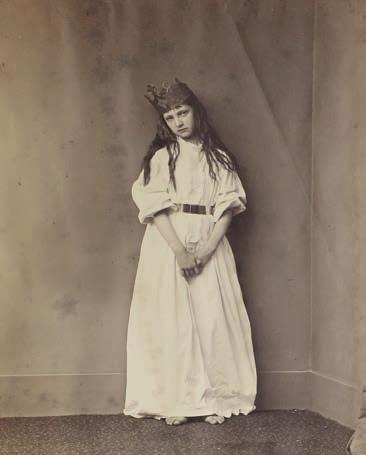
Left Lewis Carroll (18321898), photograph of Alexandra ‘Xie’ Rhoda Kitchen (1864-1925) on a chaise longe, it has an estimate of £1,000 at this month’s timed sale
Below right Lewis Carroll (1832-1898), photograph of Alexandra ‘Xie’ Rhoda Kitchen (1864-1925), asleep on a chaise longue, it has an estimate of £1,000 at this month’s timed sale
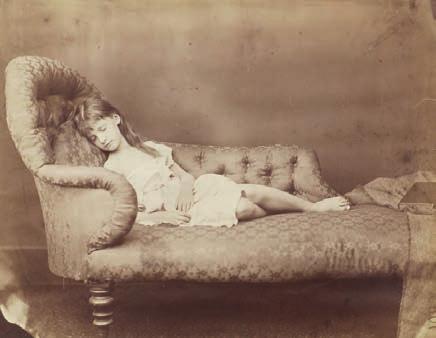

Carroll is considered one of the best amateur photographers of his time, particularly in his images of Victorian children, but it is important to remember he also photographed friends, family, fellow scholars, and noted figures of his day, including Alfred Lord Tennyson.
The images of Xie are well choreographed and the quality is remarkable. Carroll was both patient (in a process that took a great deal of time) and paid attention to the smallest detail.
Where are you hoping interest will come from?
We expect it to be international, especially from America, home to the Lewis Carroll Society of North America. We also foresee interest from collectors of early photographs, as well as those devotees of the work of the author of Alice’s Adventures in Wonderland. It really is a wonderful archive of images.
photographic
IN MY OPINION...
‘At the time, the camera was still a relatively new technology and Carroll was an early and capable enthusiast. Throughout this time, he used the collodion process, a photographic method that required optimal lighting, subjects who held perfectly still, and great deftness on the part of the photographer’
Above far left Lewis Carroll (1832-1898), photograph of Alexandra ‘Xie’ Rhoda Kitchen (1864-1925), dressed as queen wearing a crown, it has an estimate of £1,000 at this month’s timed sale
Ever heard of Picasso’s ski wear range? How about Andy Warhol’s ice cream sundae dresses? Textiles by two titans of 20th-century art go on show this month at two London exhibitions
From the mid-20th century onwards, a number of the greatest names in 20th-century art turned away from the canvas to team up with textile manufacturers to produce limited-edition textiles with the aim of transporting contemporary art into the home as never before.

Styled by Design, a selling exhibition opening this month at the London textiles gallery Gray M.C.A reveals a varied collection of rare and limited edition printed textiles from designs by Henry Moore, Barbara Hepworth, William Scott, Alexander Calder and Pablo Picasso, which, in the case of the latter, led to a range of textiles for both furnishings and mass-produced clothes.
Also unveiling this month, at the Fashion and Textile Museum in Bermondsey, is an exhibitioon of 60 fabrics and garments designed by the Pop Art icon Andy Warhol.
Both open up exciting prospects for collectors – while owning an artwork by either artist is beyond the budget of most, their textiles o er a unique insight into both artists and, in some cases, are just about a ordable.
e collaboration between fashion houses and leading artists was literally art by the yard for the masses, and something very close to a number of the artists’ political beliefs. As some of the most acclaimed names of the 20th century, none of them were in need of publicity or money but they sought to democratise art. In doing so they also opened up an exciting prospect to collectors.
Ashley Gray, from Gray M.C.A, said: “Without seeing some of these textiles in the esh it is di cult to describe their beauty. ey have all the all the complexity and texture of an oil painting. e di erence is that an oil painting, or even an etching by one of these great artists, could cost upwards of a £1m but, with a textile there is a possibility for a collector to own a limited-edition work of art for a fraction of the price.”
After WWII, advocates for the American textile industry promoted ways for manufacturers to improve the design element of their products. One outspoken champion, the magazine American Fabrics, encouraged manufacturers to nd design inspiration in the collections of ne art to be found in museums.
In 1953 Dan Fuller, president of Fuller Fabrics, went one step further. He bypassed the museums and went directly to the studios of ve of the 20th-century’s most distinguished artists: Fernand Léger, Pablo Picasso, Marc Chagall, Joan Miró, and Raoul Dufy. e ground-breaking approach resulted in the acclaimed Modern Masters Series. e artists were not commissioned to produce original patterns speci cally for the textiles. Instead, Fuller worked personally with each artist to select motifs from their existing oeuvre that were then incorporated by the company’s designers into repeating textile patterns.
Each artist’s palette was surveyed to pick the nal
Above Pablo Picasso (1881-1973) Musical Fawn, 1963, screenprinted in colour on linen, artist signature in print, Bloomcraft Fabrics, USA, 174 x 121cm


Below left Pablo Picasso (1881-1973) Carnet II, 1963, screen print on cotton, signed and dated in print Bloomcraft Fabrics, USA, 75 x 121cm
Below right Pablo Picasso (1881-1973) Frontispiece, 1963, screen print on cotton, signed in print, Bloomcraft Fabrics, USA, 90 x 62cm
colour range. In all, the process of engraving and printing on cloth required more than a year. e decision to use roller printing, rather than silk screen, was a sure indicator of the company’s intention to produce the textiles on a potentially vast scale, which they planned to sell in the lower price range at between $1.49 and $1.98 a yard.

Several leading American fashion designers, including Claire McCardell were commissioned to design clothes using the textiles which, in turn, featured in American Fabrics and a ve-page editorial in Life magazine. In it Picasso is pictured in his Cannes villa alongside the model Bettina Graziani who wears a pair of red wool jersey trousers featuring a Picasso still life, priced $55 and a dress with a sh design by the artist priced $440.
‘White Stag’s Picasso range consisted of PVC coated rainwear, ski jackets and anoraks, printed corduroy ponchos, shirts, blouses and sweatshirts, even a hostess ‘culottes’ dress, all priced between $9 and $30.25’
McCardell designed a wardrobe of separates and dress ensembles using Modern Masters fabrics which were featured in the Life photo essay.

Garment manufacturers throughout the US, such as the distinguished fashion company, Lanz of California, placed orders, and Fuller Fabrics announced that dresses for the teenage market were to be made up at about $20 a dress. A newspaper advertisement from 1956 for Pomeroy’s department store in Reading, Berks County, Pennsylvania, advertised children’s ‘Modern Masters Print Dresses in Fuller Drip ‘n’ Dry Fabric, with designs by Picasso and Chagall, for $8.98’.
A decade later, in 1963, Bloomcraft Fabrics, a New Yorkbased company founded by Charles Bloom, launched a group of 11 furnishing textiles – e Picasso Collection – the result of a collaboration between Picasso and Bloomcraft’s design studio.
It was similar in many ways to the project Picasso had been involved with at Fuller Fabrics in 1954, but on a more spectacular scale: the Bloomcraft designs were taken from a wide spectrum of Picasso’s oeuvre and silkscreen
printed on a variety of materials in a number of vibrant colourways.
A further, even more improbable, textile project also took place in 1963 between Picasso and the Oregon-based sportswear manufacturer, White Stag, the mass-produced brand of Bloomcraft Fabrics.
Above
Picador, 1959, screen-printed linen, Bloomcraft Fabrics, USA, 78.5 x 56cm

Left Pablo Picasso (1881-1973) signature on Picador, 1959, screen-printed linen, Bloomcraft Fabrics, USA, 78.5 x 56cm

Below left Part of the ve-page feature in Life magazine from November 14, 1955, Google Books, reproduced by kind permission of Life magazine
e project was the brainchild of two optimistic San Francisco-based ad men Howard Grossage and Bob Freeman, who appeared undeterred by an earlier disastrous attempt at marketing culture to the masses by selling sweatshirts adorned with images of composers. Having rst come to an understanding with White Stag, the pair went to France to meet Picasso. Secrecy was maintained until the launch with the scheme kept under tight wraps, referred to only by the code name, Project Marvin. e ad men didn’t make it to Paris, but eventually made a deal with the artist, through his Parisian representatives, for White Stag to have exclusive rights to use certain designs on fabric.
An interest in skiing had grown rapidly in Oregon in the 1930s and White Stag’s Picasso range consisted of PVC coated rainwear, ski jackets and anoraks, printed corduroy ponchos, shirts, blouses and sweatshirts, even a hostess ‘culottes’ dress, all priced between $9 and $30.25.
ere is little or no information concerning the project’s success, but, judging from the scarcity of surviving pieces, it does not appear to have been a triumph. Such projects may have been an advertising project rather than a serious commercial venture –essentially a form of ‘loss-leader’.


We asked Ashley Gray, from Gray M.C.A about the importance of Picasso’s textiles
As with the success of the Asher Squares in London, the Fuller textiles were taken on tour across the US after previewing at the Brooklyn Museum. Top US designers ensured the fabrics were seen in the highest levels of American society. A selection of the Picasso and Chagall textiles were included in the Museum of Modern Art’s Textiles’ exhibition in 1956.
Bloomcraft Fabrics’ Saison’s Happily Married was a series of screen-printed interiors textiles in a variety of fabrics and finishes, many based on his 1962 book Toros Y Toreros. Carnet II featured Picasso’s wife Jacqueline Roque Picasso on a rearing horse confronting her own image.
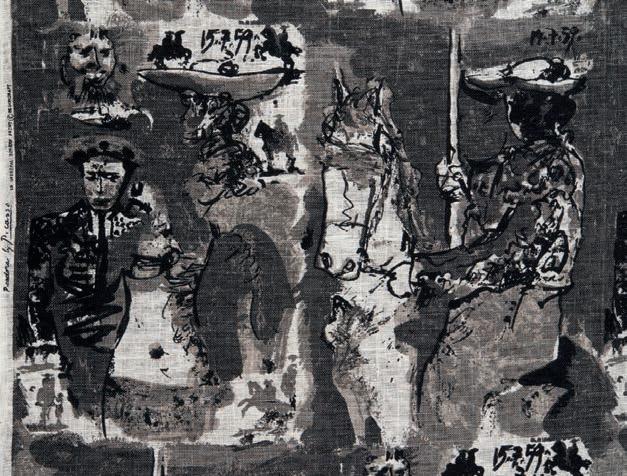
It was used to promote Bloomcraft’s Picassosigned fabrics Picasso Collection, which was a great success. Under the tag line Picasso Olé, the posters stated: “If the ordinary bores you, then this imaginative fabric collection was designed for you …. As vital, daring, and provocative as the Master himself.”
Picasso joked the fabrics were suitable for any form of interior decoration, with the exception of chair upholstery because: ”It is the wish of the Master that a Picasso may be leaned on but cannot be sat on.”
While Picasso’s textiles date from a time when he was already one of the most famous artists in the world, those by Pop Art legend Andy Warhol come from the time when he was a commercial artist scratching out a living in 1950s New York.
Post-war economic growth led to an increase in consumerism – one of the themes of Warhol’s work. New fabrics were making fashion accessible to all, so it was a short step for Warhol’s fascination with everyday items to fall on textiles.
Warhol started designing fashion fabrics for his friend Stephen Bruce, proprietor of the legendary New York eaterie, Serendipity 3, founded by Bruce and two friends, in 1954 on the Upper East Side of Manhattan. At the time Warhol was a jobbing designer in commercial and advertising art for clients ranging from Glamour magazine
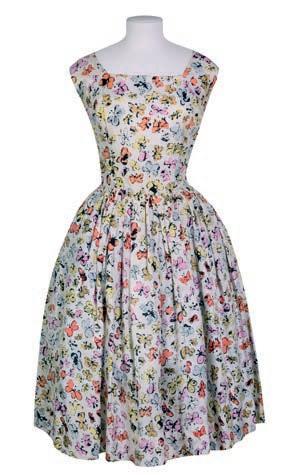
Above Textile of Candy Apples, silk by Stehli Silks, © 2022, e Andy Warhol Foundation for the Visual Arts, Inc. / Licensed by DACS, London

Left Large Nautical Flags textile, skirt, c. 1957-1958, © 2022, e Andy Warhol Foundation for the Visual Arts, Inc. / Licensed by DACS, London
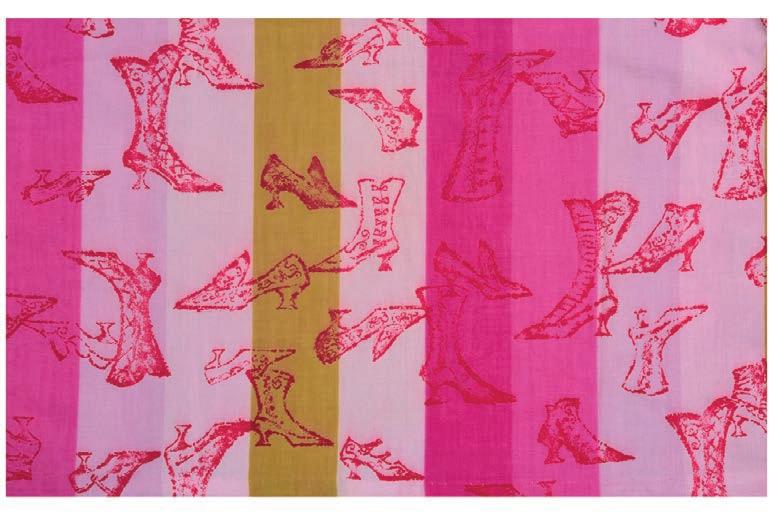

Below Luggage Tags and Suitcases textile, blouse by Cohama, 1958/1959, © 2022 e Andy Warhol Foundation for the Visual Arts, Inc. / Licensed by DACS, London

‘Warhol started designing fashion fabrics for his friend Stephen Bruce, proprietor of the legendary New York eaterie, Serendipity 3 founded by Bruce and two friends in 1954 on the Upper East Side of Manhattan. At the time Warhol was a jobbing designer in commercial and advertising art for clients ranging from Glamour magazine to Miller shoes’Left Textile of Ice Cream Cones, silk by Stehli Silks, pink and blue dress, 1962/1963, © 2022, e Andy Warhol Foundation for the Visual Arts, Inc. / Licensed by DACS, London Right Happy Butter y Day textile, silk dress by Needlecraft, c. 1955, © 2022, e Andy Warhol Foundation for the Visual Arts, Inc. / Licensed by DACS, London
As well as acting as a pop-up gallery, the café and its menu went on to provide a source of inspiration. Serendipity 3’s menu featured iconic American classics, including foot-long hot dogs, it was also known then, and now, for its extravagant desserts, particularly elaborate ice cream sundaes. It was against the background of this fashionable spot (Marilyn Monroe and Jackie Kennedy were among the cafe’s customers) that Stephen Bruce took up fashion design, manufacturing garments on the second oor of the Serendipity building.
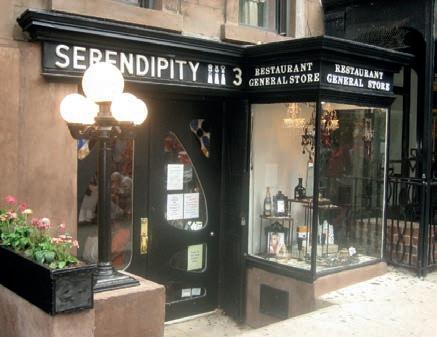
Warhol’s textile designs for Bruce, two of which were used for a Serendipity fashion collection, were derived from food associated with the cafe. ey are in a transitional style prescient of Warhol’s later Pop work; one has a pattern of giant pretzels and the other of oversized ice cream cones.

Left Ice Cream Desserts, © 2022, e Andy Warhol Foundation for the Visual Arts, Inc.
/ Licensed by DACS, London

Right Acrobatic Clowns and Horses textile, c. 1955, © 2022, e Andy Warhol Foundation for the Visual Arts, Inc. / Licensed by DACS, London


Below left e New York café attracted the bohemian set of the 1950s, including Andy Warhol, image Wikicommons
Below right Happy Bug Day textile 1955, © 2022, e Andy Warhol Foundation for the Visual Arts, Inc. / Licensed by DACS, London
Warhol’s border-printed textile Acrobatic Clowns and Horses demonstrates his talent as a textile designer and is a masterpiece of pattern making, with the circus clowns’ kinetic sequence of somersaults making for the perfect repeat pattern. The textile’s design is close in style to Warhol’s illustrations for children’s books in the 1950s, the horse being particularly reminiscent of many similar images by him.
Throughout his commercial career Warhol recycled and redrew images to create pattern designs for a wide variety of purposes, including textiles. The clown image is a variation of one devised by Warhol, in 1950-1951, for a proposed, but unpublished, Christmas card for New Directions Publishing in New York.
Two cotton fabrics from the 1950s are also known: Warhol’s Happy Bug Day design and the other with a variation, Happy Butterfly Day Th e butterfly motif chimed distinctly with Warhol, and it is seen several times as inspiration for other designs throughout the later 1950s, using a version of it in 1960 for the design of a particularly outstanding fashion textile, Butterflies. The textile, manufactured by Nat Wager, was used for dresses and blouses designed by Robert Sloan which were featured in a 1960 issue of Glamour magazine.
Styled by Design at Gray M.C.A, Cromwell Place, London, SW7 2JE, from April 18-30 bringstogether textiles by a number of artists including Pablo Picasso, Henry Moore, Barbara Hepworth and Patrick Heron, with pricesranging from £1,500 to £170,000. Andy Warhol: TheTextiles, cocurated by Richard Chamberlain and Geo Rayner of Target Gallery, is on at the Fashion and Textiles Museum in Bermondsey from March 31 to September 10. The exhibition is accompanied by the book, Warhol: The Textiles, £30, Yale, authored by Geo Rayner and Richard Chamberlain. This article isadapted from their book Artist Textiles 1940-1976, published by Antique Collectors’ Club.
Its contents – worthy of a period drama – are being painstakingly catalogued and there is much to do. e home’s high ceilings and ample space includes three reception rooms, a snug, living room and four bedrooms full of fascinating objects.

The 300-lot contents sale of a Georgian home in Derby’s Friar Gate is set to attract bidders from around the world, thanks to the enduring interest in quintessentially English style.
Belper-born Gail Brotherton moved into the 1770 house almost 60 years ago and with her eclectic taste and interior style created a historical treasure brimming with elegance.

She spent her days visiting auction rooms in Derbyshire and London collecting pieces from di erent periods to decorate the house in a unique way.
It was a privilege to step inside, sense the history and soak up the lingering atmosphere of happy times. Amid the elegant furniture and glowing lamps, I spied a multitude of objects from a rocking horse, spinning wheel and stained glass windows to taxidermy, textiles and even a large collection of Chanel No.5 perfume bottles.
Above e contents of the Georgian townhouse go under the hammer at Hansons
Above right A portrait of an unknown woman in period gown was dated to c. 1840 thanks to her snake bracelet

Left One of several clocks o ered for sale from the Derby home
My eyes itted from one item to another, struggling to take it all in. Artwork, silver, ceramics, elegant furniture, period lamps, walking canes, hats, clocks, militaria and more all fought for attention. Some antiques may have come with the house, in situ for centuries. For example, a portrait of an unknown woman in a period gown (above) which we have dated to c. 1840, thanks to a snake bracelet the woman is wearing – such styles were prevalent in the mid 19th century.
A nd with local connections is a ‘Woolley Codnor’ longcase clock, expected to make £600-£800. James Woolley (1695-1786) was a renowned watch and clockmaker from the Derbyshire village of Codnor.

A surprising nd which turned up in the attic was an En eld ri e from 1888. An En eld is a magazine-fed repeating ri e that served as the main rearm of the military forces of the British Empire and Commonwealth. It was the British Army’s standard ri e from its o cial adoption in 1895 until 1957, making this example extremely early. Still on a military theme, we found a pair of WWI cavalry o cer’s boots, a faux suit of armour and an REM (Royal Engineers) army jacket. Looking to the Far East we also stumbled across an array of Chinese and Japanese jewellery boxes. All in all a veritable treasure trove that has to be seen to be believed.
e sale of the contents of the Derby Georgian townhouse is on March 29. Go to www.hansonslive.co.uk to bid.
In its heyday the original home owners would have been the near neighbours of Joseph Pickford (1734–1782) one of the country’s leading architects during the reign of George III, who moved to Derby in 1763.
In 1770, Pickford designed his own townhouse in Friar Gate where he lived with his wife Mary and their two sons, together with their servants and their dog – the children and the dog became a subject for a well-known painting by Joseph Wright of Derby. Pickford’s House is now a museum celebrating the city’s Georgian past.
In Georgian times Derby was a hub of societal innovation, attracting mill owners and the rising upper and middle classes and putting the city at the centre of the Midlands Enlightenment. Erasmus Darwin moved to the city in 1783, where he founded the Derby Philosophical Society.
whose Georgian home is awash with hidden gems
‘Amid the elegant furniture and glowing lamps, I spied a multitude of objects from a rocking horse, spinning wheel and stained glass windows to taxidermy, textiles and even a collection of Chanel No.5 perfume bottles’
Above Left to right: a diamond brooch, 1920s with circular-and rosecut diamonds (estimated to make £1,000-£1,500; a diamond brooch, 1930s (estimated to make £1,000-£1,500) and a diamond double clip brooch, 1950s (estimated to make £5,000-£7,000).

All three are in Olympia Auction’s sale on May 24


Long considered the preserve of grandmas, ‘80s power suits and the monarchy, the brooch is back in vogue. According to e RealReal’s 2023 luxury report, demand for brooches was up 27 per cent during 2022. Perhaps sparked by the global hit e Crown, with the hashtag #brooch gathering more than 100 million hits on Twitter. Add to this the perennial appeal of art deco, and you have a sure- re collecting trend on your hands.
Right Diamond brooch, 1920s, designed as an open work plaque of millegrain honeycomb links with scroll motifs, set with circular-and rose-cut diamonds, approximately 65mm x 40mm, it has an estimate of £1,000-£1,500 at the same sale

Brooches have adorned clothes for millennia, initially a humble pin to hold a garment together, they soon developed into an elaborate jewel, and no more so than during the inter-war period that today we term art deco.
Fixed to the collar, lapel, waist, or even to a hat, they showcased the latest design trends and, in some instances, could even make subtle political statements.
By the end of WWI fashions were already superseding the garlands and swags of the Edwardian Belle Époque. But it was the seminal international Paris Exposition of 1925, Exposition Internationale des Arts Decoratifs et Industriels Modernes that announced the new style moderne to an international audience.
e landmark exhibition was to later lend its name to the movement, coined by the British Historian Bevis Hiller with his book Art Deco, exploring the decorative arts of the 1920s and 1930s, published in 1968.
‘Geometric designs were favoured due to their versatility, but inspiration was also taken from Chinese, and South American art where the motifs’ geometric designs would work, such as the Chinese Ruyi symbol or Aztec pyramid, that could be easily rendered in diamonds to form a double clip brooch’
none more so than
e movement drew on a variety of sources for its inspiration, from Cubism, Futurism, Soviet Brutalism, Industrialism and Orientalism, as well as looking to the cultures and arts of China, India, Egypt, South America and the Sudan. However, the principal themes running through all art deco designs were a strong geometric form, striking contrasting colours and lavish ornamentation.
Ideal showcase
e brooch was the ideal vehicle to showcase such ideas and became a wearable miniature work of art. Some of the earliest designs held a strong similarity to pre-war Jugendstil design, showcasing hammered decoration and rivets. One of the most notable designers to employ such techniques was the French silversmith Jean Després (1889-1980) who was heavily in uenced by his work as an aviation engineer during WW1. While clockmaker-turnedjeweller and goldsmith Gérard Sandoz (1902-1995) embraced materials for their a ect, rather than intrinsic value, such as silver, lacquer and enamel.
ese designs were just one oeuvre available to the fashionistas of the new art modern movement. Jewellery of the period also showcased the highest-quality metals such as platinum and chromium, and vibrant, clean cut gemstones like diamond, emerald and sapphire. A combination of these factors makes art deco brooches some of the most sought after at auction.
e most ingenious adaption of the brooch in the interwar period was the creation of the double clip.
Left French art deco diamond and sapphire brooch, image courtesy of Lang Antiques

Right In 1944 Cartier launched the liberated bird brooch, image courtesy of Christie’s
Below left Art deco Japonesque French brooch c.1925. Fused glass, mother-of-pearl, diamonds, onyx and enamel, image courtesy of Lang Antiques

Below right A diamond double clip brooch, 1950s, of scrolled ribbon design set with circular-, single-cut and baguette diamonds, detachable brooch pin, it has an estimate of £5,000-£7,000, at Olympia Auction’s sale on May 24


The most famous brooch of the period was perhaps the iconic caged bird brooch created by Jeanne Toussaint, Cartier’s creative director. Created in 1942, during the height of the German occupation, the caged bird represented the imprisoned and supressed French nation in open defiance towards the German aggressors. The caged bird brooch was followed by another in 1944 to celebrate the Liberation depicting an open cage with a bird poised to fly away (above). The bird’s colours of red, white and blue simultaneously represented the colours of both the liberated French and the Allied forces of the UK and US.

It was a brooch formed of a pair of smaller clips that could be adapted to wear on the collar, sleeve and even in the hair – or on the ubiquitous cloche hat.
Geometric designs were favoured due to their versatility, but inspiration was also taken from Chinese, and South American art where the motifs’ geometric designs, such as the Chinese Ruyi symbol or Aztec pyramid, could be easily rendered in diamonds to form a double clip brooch.
Another art deco brooch invention initiated by the French jewellery house Van Cleef and Arpels was the circle clip, an ingenious hinged sprung circular brooch that could be xed to a collar, sleeve, hat or purse, clasping the fabric as if by magic.
A favoured form of brooch fashionable during the art deco period was the jabot or sûreté pin. Formed of a pair of decorative terminals, the pin would be concealed when worn thus creating the illusions of a pair of motifs oating on a garment at a jaunty angle. In some instances, the head of the pin would be embellished with an elaborate motif such as the fabulous Cartier Indian-inspired paisley motifs, inspired by the sarpech or turban ornaments of Indian princes, usually trailing a tassel of gems or pearls. Such jewels were frequently worn either on the lapel or hat and could become quite large mimicking the hat pins of previous generations.
In 1922, with the discovery of the tomb of Tutankhamun in the Valley of the Kings, a frenzy of Egyptian mania quickly spread. Cartier London placed a full colour page advertisement in the Illustrated London News in January 1924, to showcase their new Egyptian-inspired designs, incorporating genuine ancient Egyptian antiquities, from fan-shaped brooches to jabot pins.

While Van Cleef & Arpels favoured replicating Egyptian wall decorations in bu top emeralds, rubies and sapphires. e French jewellers Boucheron, founded by Frederic Boucheron in 1858, meanwhile adopted the colour palette of Egyptian designs, exhibiting Egyptianinspired jewels of black, red and blue at the Paris Exposition of 1925. e most notable being a specially

Below left Brooch with spread wings motif, unknown manufacturer, France, c.1925

Bottom left A Cartier advert, in the Illustrated London News, January 26, 1924
Below e Eye of Horus bracelet by Cartier was commissioned by Linda Lee Porter in 1928 (left). e scarab belt buckle brooch, also by Cartier, was commissioned by her in 1926 (right). Photo credit Siegleson, New York

Below right A Tutti Frutti ring by Cartier, taken from Celebrating Jewellery published by ACC Art Books
For the less well-heeled who couldn’t a ord to acquire antiquities or Cartier’s lavish modern jewels, inexpensive replicas of ancient jewellery were produced in silver and enamel. Pieces of this type were mostly produced on the continent, particularly in France and Germany. Also at the more a ordable end of the market, one can nd wellknown makers at very reasonable prices. Charles Horner is one such maker, who used a variety of Egyptian motifs in some of his 1920s designs. e most recognisable of these designs are probably his winged scarab brooches, which tend to fetch in the range of £100-£200 at auction.
Colour was paramount and the use of red, blue and green was ingeniously employed by Cartier with its Indianinspired Tutti Frutti creations, incorporating carved gemstones, initially taken from antique Indian jewels. ese Hindou jewels were sometimes set with fabulous carved Mughal emeralds reimagined with modernist mounts.
e use of such stones was highly innovative as previously such carved stones would have been frowned upon as being unfashionable to modern taste. e use of such carved stones into jewels of the period soon became highly fashionable and was copied by many jewellers, such as Maubousin and Lacloche Frères, however it was to be the house of Cartier that we associate with Tutti Frutti. Colour was an important element of all art deco design, contrasting blue and green, orange and black and black and white, using both enamel, lacquer and gemstones to achieve the desired e ect.
In the years that followed, Cartier created many beautiful Tutti Frutti pieces including brooches, cigarette cases, earrings, and bracelets. Diamonds, rubies, sapphires, cabochon and emeralds were set in oral designs, with a row of diamonds representing the traditional Indian Mughal art. Rubies and emeralds were interspersed with onyx berries set in platinum, as was customary at this time. A telltale zig-zag of black enamel, however, also became a signature element.
e Paris Colonial Exposition of 1931 was an international exhibition held to showcase the diverse cultures of French colonial possessions. Other nations that participated included, Italy, e Netherlands, Belgium, Japan, Portugal, the United Kingdom and the United States,
however it was the focus on the arts and cultures of Africa that was of primary importance and which ltered into art deco design.
Boucheron created a series of dramatic jewels of African inspiration set with malachite, red glass, ivory and gold. e use of ivory, gold, wood and lacquer were favoured. A 1931 Vogue article noted, “Boucheron has made a whole-hearted response to the Colonial Exhibition that has aroused everyone’s interest and delight.”

e feature goes on to describe Boucheron’s use of “frankly barbaric” materials such as the teeth and claws of “savage beasts, which were set into soft and primitivelooking yellow gold” to create their jewelled masterpieces. Meanwhile, Cartier created jewels labelled Sudanese in homage to the fashion. Ivory brooches inlaid with black lacquer in elaborate scroll formations were favoured, and although only loosely inspired by African design, they became another area that the art deco movement enveloped.
Justin Roberts is a senior jewellery specialist at Olympia Auctions in London, its next jewellery sale, which includes three brooches mentioned in this article, takes place on May 24. For more details go to www. olympiaauctions.com

Left A 1930s jabot pin in Tutti Frutti style in the collection of the late Patricia Edwina Victoria Mountbatten, the last Vicereine of India, image courtesy of Sotheby’s
Right An art deco double clip diamond brooch
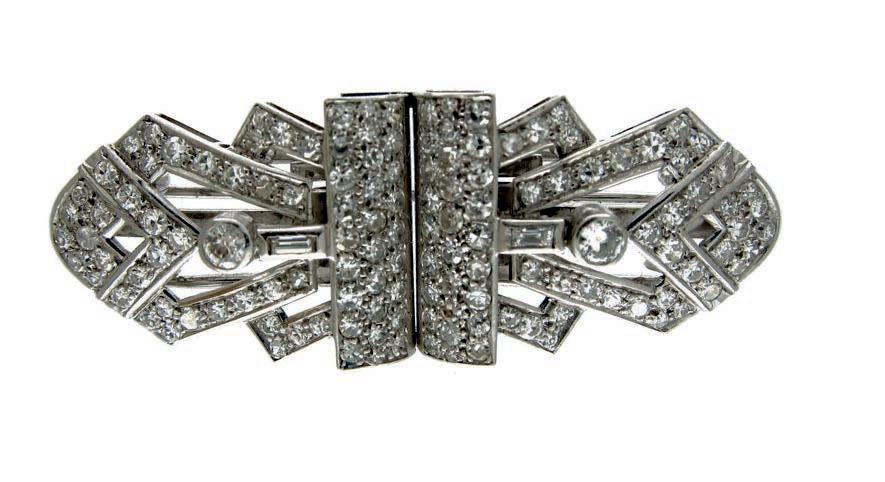
Below A design in the African style by Boucheron for the Colonial Exhibition of 1931. e malachite came from the Congo, a French colony, the polished gold beads refer to cultural signi cance of Ashanti gold, image courtesy of Sotheby’s
Although the best examples employ diamonds and platinum, others can readily be found in silver, lacquer and enamel.
In building a collection one should always study the reverse of any jewel as much as the front. The back is a great indication of both quality and can reveal any adaptions or later alterations. Smaller double clip brooches have sometimes been adapted to form ear clips, while the original double prong fittings are sometimes replaced by modern brooch pins, all things to look out for as such alterations will lower the value.
It is also worth studying single clip brooches to see if they may have originally formed part of a double clip brooch. Art deco clip brooches were produced as single examples, however, normally the edges will be gem set and would never have been able to fit to a pair, whereas a single clip with a plain flush edge may indicate that it originally had a companion.
One of the leading makers to look out for, such as Cartier, will always command a premium, however several lesser-known goldsmiths produced jewels in the art deco style. Invariably unsigned, these can present a large spectrum from which to start collecting. Look out for lesser known designers such as Arnold Ostertag who opened a jewellery house in Place Vendôme in 1922. Pieces which aren’t signed but are well made will be at a more accessible price point.
If buying at auction, make sure you ask for further images and a condition report, and ideally try and view the jewellery in person and talk to the specialist.
Gemstones are categorised and priced according to the four ‘Cs’ – carat (weight), colour, clarity and cut. Coloured gemstones can also have enhancements, which is important to look out for. As recently as the 1960s and ‘70s many art deco brooches and jewellery were sold for their intrinsic value and sadly broken up, today this is not the case and they are appreciated for their artistic merit. Modern in style and highly wearable art deco brooches also provide a fascinating insight into the design movement of the inter-war period.

Q1 e name Arkwright is associated with 18th-century spinning and weaving of material. What was the (main) advantage of his (c. 1769) machine? (a) lightness of frame, (b) size of frame, (c) using extra strong cotton, (d) price.

Q2 You are o ered for sale something with shutlocks, summers, sweep and futchels. What is it? (a) a 1930s plough, (b) an early 20th-century wagon, (c) a Victorian corset, (d) a mummer’s costume.
Q3 You nd a collection of late 1800s drawings with the words ‘after B’ written on each. ey show how to construct a serpentine, a heart, and a eur-de-lys using a straight-edge and compasses. In what context were they most likely to have been drawn? (a) garden design, (b) carpentry, (c) architecture, (d) fabric decoration.
Q4 e preferred medium for sleeves for displaying coins used to be PVC. What was wrong with the material? (a) it became opaque over time, (b) it became brittle, (c) it damaged the coins, (d) its price increased due to demands on supplies by the fashion industry.

Q5 A sale of 300-year-old ‘Neapolitan’ artefacts includes a tricche-ballacche. What is it? (a) an early croquet mallet, (b) a three-legged gaming table, (c) a hat with tassels, (d) a musical instrument.
Q6 If an old sculpture/object is described as ‘quadriga’. What is it? (a) any four-legged mythical beast, (b) a chariot drawn by four horses, (c) a foursided (either square or rectangular) decorative design, (d) a container for ancient knick-knacks.
Q7 Alvan Fisher (1792-1863) was an American artist. What is he remembered for (more than one answer)? (a) portraits, (b) landscapes, (c) native American life and culture, (d) farm scenes.
Send your answers to Crossword, Antique Collecting magazine, Sandy Lane, Woodbridge, Su olk, IP12 4SD, UK. Photocopies are also acceptable, or email your answer to: magazine@ accartbooks.com. e rst three opened by April 10 will win a copy of Jackson’s Hallmarks, Pocket Edition: English, Scottish, Irish Silver & Gold Marks From 1300 to the Present Day, worth £6.95

Q8 What was known as a ‘Pope Joan’? (a) a late 18th-century game, (b) an early 18th-century bonnet, (c) a 1920/30s car designed and marketed for ‘ appers’, (d) a sh-kettle.
Q1 What was the main advantage of Arkwright’s spinning machine?
Q9 What was harratine or harrateen? (a) anything from Henry VIII’s reign, (b) 18th-century linen bedcurtain fabric, (c) a corruption of harem, hence for use by eunuchs, (d) 17th-century Scottish wig-oil used by young men-about-town.
Q10 In the 1960s the Wade group of potteries produced products aimed at (a) bank savers, (b) Disney devotees, (b) shavers with an interest in cars, (d) teenagers, television fans and pet lovers?
Q4 Coins are best advised not to be displayed in PVC
Q7 For which genre is the American artist Alvan Fisher (1792-1863) best known?
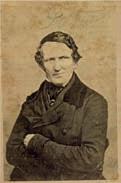
The letters in the highlighted squares when rearranged form the names William and Mary. The three winners who will each receive a book are Mary Fisher, by email; Dr Lee Harvey, Hants and Vince Cooper, Stoke, by email.
Finally, here are four anagrams Demon’s rim, Anti-poms, cow stain, lost hoteliers. Rearrange them to form, in order:
A 1920s and 1930s style that broke with the past. An Italian term for blue-and-white stencil decoration. A type of early joined chair with a panelled back, wooden seat and open arms.
Creamware decorated with glazes mingled to produce a variegated e ect.
Find answers on page 10.
Give your brain a spring clean with our quiz and a head-scratching crossword puzzle from Peter Wade-Wright
4 Iron coated after exposure to damp air. (5)
6 Originally (1949) an East Yorkshire pottery company known for Toby jugs, slipware etc. (7)
7 Beaujolais variety of grape. (5)
9 China clay. (6)
10 A double music stand would be used for this. (4)
13 Abbreviated ‘backbone’ of the armed services (sing.) (1. 1. 1.)
15 Largest Inner Hebrides island…stunning and often painted. (4)

18 Coarse canvas. (6)
19 Pen name of the Belgian artist who created Tintin. (5)

21 Museum collection official…and expert. (7)
22 Prefix denoting ‘British’…or of such origin. Hence ____- Venetian glassware or ice glass made in England during the 1850s. (5)
1 Originally 18th-century North American religious communities… producers of simple, unadorned furniture. (7)
2 Place where weapons are kept. (7)
3 Allocate to a particular artist. (6)
4 With 5-down. Informal (and not very polite?) name for the fashion industry. (3, 5)
5 See 4-down. (5)
8 Primitive type of plough. (3)
11 Furniture designed by Sir Gordon Russell in 1942 at the government’s request. (7)

12 See 17-down.
14 The work of an artist, writer etc. (from French…the word, not the artist). (6)
16 Calvin _____ (b. 1942). Fashion designer with his name now on perfumes, watches etc. (5)
17 Fast-drying paint medium commonly used in Medieval art. (3, 7)
20 Umberto ____ (1932-2016) Italian Medievalist and author. (3)
Finally, rearrange the letters in the highlighted squares to form the name of a timepiece (sing.) with no apparent connection between the workings and the hands. (7, 5)
Expected to make more than £21m at a special stand-alone sale this month, this 11.3cm bowl could be one of the most important Imperial porcelains in the world
In 2006, to celebrate his 80th birthday the legendary Chinese art collector, Richard Chang, sold part of his collection, including a delicate white bowl bearing the mark of the Qianlong emperor (1736-1795).

e woman who paid £10m to secure it, setting a new record for art sold in Asia, was his sister Alice Cheng – one of the one of the most in uential women in the former British colony.
is month, 17 years later, the same bowl goes under the hammer again, this time with an expected price tag of £21m. Once owned by the Woolworth heiress Barbara Hutton, its swallow pattern decoration and famille rose glaze are said to make it a masterpiece of its genre. A complementary bowl is in the collection of the Percival David Foundation in London.
Falangcai (meaning ‘foreign colours’) remains the rarest and most sought-after imperial ware. It refers to porcelains painted in the imperial workshops of the Forbidden City in Beijing during the Qing dynasty (16441911).
e idea that porcelains from Jingdezhen could be enamelled close to the imperial living quarters, to enable the emperor to follow and examine the results rst-hand, was initiated by the Kangxi Emperor (r. 1662-1722).
Pieces painted with the sparse and re ned natural scene as seen on the Dr Alice Cheng bowl, ‘wrapped’ around the vessel like an unrolled handscroll, were produced in Beijing for only a very short period.
ey are characteristic of the Yongzheng reign (17231735) and the present bowl with its imperial Qianlong reign mark (1736-1795) must date from the earliest years of that period. is small group of porcelains, today mostly preserved in the National Palace Museum, Taipei, represents the peak of painting on porcelain, an artistry that was never surpassed – or even equalled – in the imperial kilns at Jingdezhen under the supervision of Tang Ying.


Bird and ower paintings were one of China’s classic painting genres, popular at the court since at least the Tang dynasty and rmly established by the Song dynasty,
The history of the bowl, one of a pair, can be traced back to the late Qing dynasty when it belonged as one of a pair to Captain Charles Oswald Liddell (1854-1941), who went to China in 1877.
The pair of bowls was split at a sale at Bluett & Sons, London, in 1929 when it was acquired by Charles Ernest Russell (1866-1960) and his counterpart The Hon. Mounstuart Elphinstone. While one of the pair joined the renowned collection of Sir Percival David, the present bowl entered the collection of Barbara Hutton (1912-1979) heiress to the Woolworth empire between 1929 and 1956, before being sold at Sotheby’s in 1971 to J.T. Tai (19111992). In 1985, it was acquired by Robert Chang in whose collection it remained until being sold in 2006 to Dr Alice Cheng.
Below left e bowl has an estimate of HK$200m/ £21m
Below right e bowl has the imperial Qianlong reign mark (1736-1795)
when the subject of swallows and either apricot or willow trees appears for the rst time.
In the Yongzheng period, bird-and- ower motifs became a favoured topic for falangcai porcelain in the wake of court painter Jiang Tingxi’s in uential (1669-1732) Manual of Birds produced during the Kangxi period. e motif of two swallows, a fruit tree in bloom and a willow sprouting its rst leaves, on this bowl heralds the advent of spring. Even on their own swallows have traditionally been regarded as auspicious in China. Swallows are a sign of spring, and symbolise success in the future, happiness and the arrival of children.
‘In Buddhism the willow is a sign of humility, and in Buddhist rituals water was sometimes sprinkled using a willow branch to increase its purifying effect. Brooms made from willow were often used to sweep the tombs of ancestors in acts of filial piety at the time of the Qing Ming Festival’
Swallows tend to build their nests in cracks and crevices in buildings, therefore are seen as repairing them, thus bringing new life to the old. Swallows nesting in a building was regarded as an omen for success or renewed prosperity for the family living there.
In Buddhism the willow is a sign of humility, and in Buddhist rituals water was sometimes sprinkled using a willow branch to increase its purifying e ect. Brooms made from willow were often used to sweep the tombs of ancestors in acts of lial piety at the time of the Qing Ming Festival. Willow was also thought to be able to ward o blindness and was sometimes used to adorn women’s hair in springtime. Willow branches were given to friends who were about to undertake journeys, to o er protection during their travels.
Imitating an unrolled handscroll wrapped around the exterior of the bowl, the opposite side is inscribed with a colophon taken from a poem said to have been commissioned by the Wanli Emperor (r. 1573-1620).
It reads: Yu jian chuan hua guo, Ni chang dai yue gui, in English, Scissors of jade cut through the owers, Like rainbow garments brought back from the moon. e seals before and after the colophon are often seen on Yongzheng pieces and rarely on Qianlongmarked falangcai. A pair of larger bowls bearing Yongzheng marks in the collection of the National Palace Museum Taipei is likely to have been painted by the same court enameller as the present bowl at the Forbidden City.
e Dr Alice Cheng Falangcai Bowl appears at a standalone auction at Sotheby’s Hong Kong on April 8, with an estimate of HK$200m/ £21m, with a preview from April 1-7 at Hall 1 of the Hong Kong Convention and Exhibition Centre.

Below e Ode to Spring bowl is described as the greatest imperial porcelain in private hands
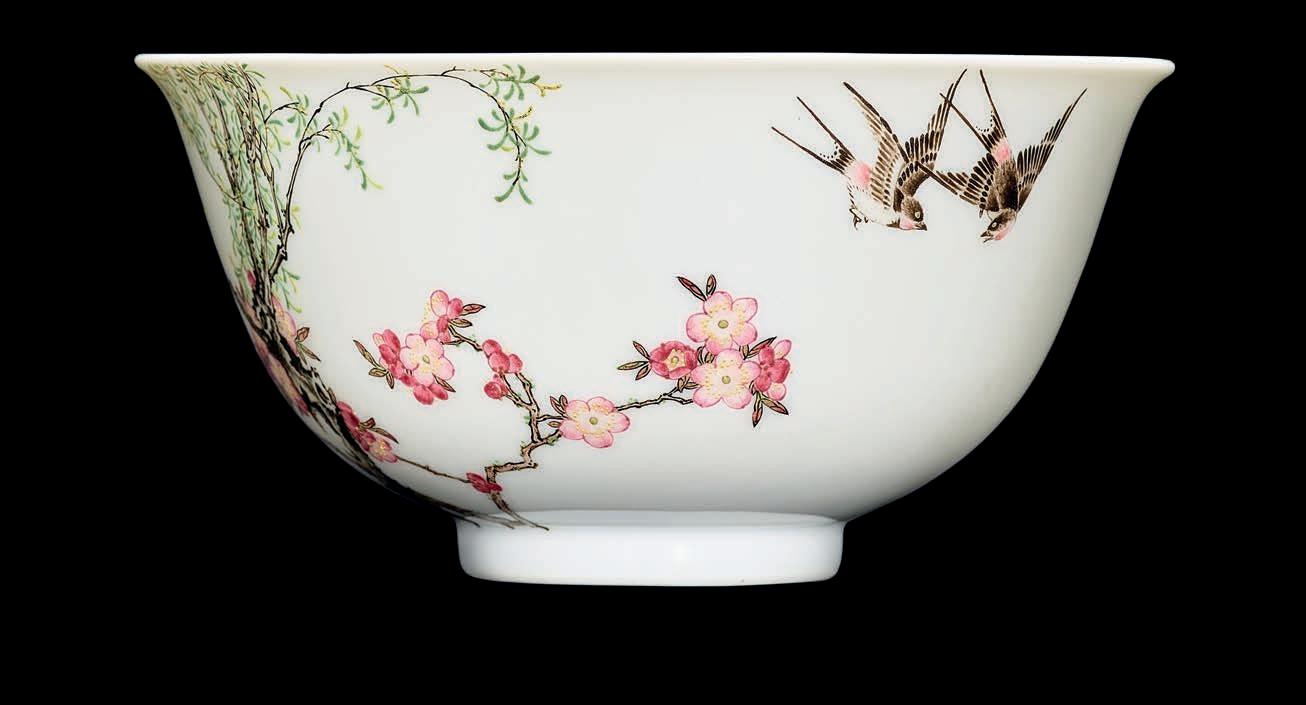
While British and American collectors had dominated the Chinese antiquities market in the first half of the 20th century, Robert Chang and his sister Dr Alice Cheng were part of an important coterie of Chinese collectors who helped turn Hong Kong into a hub in the second half of the 20th century.
Few collectors in recent history have enlivened the Hong Kong salerooms to the same extent as Dr Cheng, who forged a career as the managing director of Chinese Taching Petroleum and is a representative of the Beijing-based advisory body, the Chinese People’s Consultative Conference. Her dramatic entrance at an auction often heralds a new record price for Chinese porcelain. In May 2002, she paid HK$41.5m for an enamelled vase from the reign of Emperor Yongzheng (1723-1735), a record at the time for a Qing ceramic.
Born in Shanghai, Dr Cheng’s father, Zhang Zhongying, was a celebrated antiques dealer, in whose footsteps her brother Robert would later follow and build an illustrious career in the field of Chinese art.
When Julian Thompson, the late chairman of Sotheby’s, brought auctions to the city in 1973, his first port of call was Robert Chang who supplied hundreds of pieces to his early sales.

Designed by Swedish artist and designer Folke Jansson in 1955 for the Gothenburg furniture exhibition, the three-legged Arabesk chair received instant attention. But despite the accolades it went on to sell in surprisingly low numbers reportedly retailing only 75-100 chairs. Still fewer sofas in the range, produced in 1955-1956 by the cabinetmaker S.M. Wincrantz Möbelindustri, were sold.

As a result the design went into oblivion and was only rediscovered in the 1990s when a set came up for auction at Bukowskis.
e design did, however, excite more interest in Europe. In the ‘70s, the Vitra Design Museum added an Arabesk to its collection.
Kerstin
Axel Larsson was one of the great Swedish Modernist designers. He was head of one of the largest and most in uential furniture makers, Svenska Möbelfabrikerna Bodafors, SMF. During his years as head of the brand some of the most important chairs were produced and designed.
Larsson himself was a big part of the Modernistic movement and made several functional classics for important exhibitions such as the 1930 Stockholm Exhibition.
e chair (above) was designed in 1939 the same year several of Larsson’s chairs were shown at the New York World’s Fair.
e stitched leather and curved back are signi cant details of Axel Larsson’s chair designs of the time.
Folke Jansson (19202016) Arabesk lounge chair for Ihreborn, 1955, estimated at 12,000 SEK (£950), it sold for 13,100 SEK (£1,000), image courtesy of Bukowskis

Hörlin-Holmquist started her higher education in England immediately after WWII where she studied art history becoming fascinated with classic English upholstered furniture and style.
She continued her studies at Konstfack University of Arts, Crafts and Design in Stockholm from 1948 to 1953, launching a number of designs including her large and small Kraal rattan chairs, with a distinctly African in uence.

Today she is primarily known for the designs she created working for Nordiska Kompaniet from 1952 for which she created a group of furniture called Paradise
Her collaboration with Nordiska Kompaniet lasted till 1964.
iconic chairs every collector should be on top ofHörlin-Holmquist (1925-1997) Lilla Kraal chair, for Nordiska Kompaniet, had an estimate of 3,000 SEK (£240) at the same sale, image courtesy of Bukowskis Axel Larsson (1898-1975), a Swedish modern oak chair, Svenska Möbelfabrikerna Bodafors, 1930s-1940s, estimated at 3,000 SEK (£240), it sold for 2,000 SEK (£160) on February 25, image courtesy of Bukowskis
Yngve Ekström is the designer behind the Lamino, the best-selling easy chair ever sold in Swedish history. Designed in 1956 it was an ergonomic and minimalist easy chair which has been in continuous production ever since.
Two years earlier in 1954, Ekström created another chair that made a long-lasting impression. While today accessible furniture at a reasonable price has been made globally famous by Swedish companies such as Nordiska Kompaniet and IKEA, in the 1950s it was big news. Known in the factory where the chairs were produced as “four in a box”, the name was later changed to ema taken from Ekström’s favourite composer Bach. With its low back and chubby seat, the ema has a very personal look and was soon referred to as a Swedish classic.
Ekström was the co-founder of the furniture manufacturer ESE-möbler (later renamed Swedese) with his brother Jerker and business partner Sven Bertil Sjöqvist.
John
Solitär armchair, Källemo AB, Värnamo, late 20th century, estimated at 6,000 SEK (£480) it sold for 5,100 SEK (£400), image courtesy of Bukowskis

Yngve Ekström (1913-1988)
a set of three ema, mid 20th-century, estimated at 4,000 SEK (£320) it sold for 3,000 SEK (£240), image courtesy of Bukowskis

e Swedish architect, designer and painter was born in Helsingborg and trained at the Konstfack School of Arts in Stockholm. e “chieftain’s” chair, known as the Solitär, was the rst chair he designed for the renowned company Källemo.
e model was designed in 1985 and shown at the Stockholm furniture fair in 1986. After much industry debate the chair was dubbed “the most idiosyncratic chair of the year”. It was made rstly in mahogany and later in birch with a leather seat.
Solitär was the beginning of a lifelong friendship between Kandell and Källemo’s director Sven Lundh. e duo had a great in uence on Sweden’s design scene during the 1980s and 1990s. In many ways the chair represents the essence of Kandell’s playful and sculptural aesthetics. e design was also produced as a limitededition cast bronze sculpture.
is design duo known as Lindau & Lindekrantz had an immense in uence on early post-modern movement in Sweden. Several of their designs are considered classics and good examples of the post-modern zeitgeist uniting art and design.
eir 1985 swivel chair Planka, Swedish for plank, was humorously inspired by a man on a surfboard using a towel as the neck rest. It was also a tribute to their favourite Dutch artist and designer Gerrit Rietveld and a homage to his simple plywood chairs from 1910.

Lindau & Lindekrantz went on to be remembered as the most innovative designers of the 1980s. eir focus was making innovative designs for the industry and, with the maker Lammhults, had a lasting impact on the Swedish design. Lindau later started his own company Blå Station which remains a great in uence on today’s designers.
Börge Lindau (1932-1999) and Bo Lindekrantz (19322020) Planka swivel chair for Lammhults, 1985, estimated at 2,500 SEK (£200) it sold for 4,640 SEK (£370), image courtesy of
e Etcetera chair was presented at the Stockholm furniture exhibition in 1971. Ekselius developed the design during his years at the Royal Collage of Art in London where he presented it as part of his degree show before taking the design back to the family company J.O. Carlssons, later JOC, in Vetlanda Sweden. Since then the Etcetera has been considered an iconic piece of ‘70s furniture due to its minimalistic and timeless design.
e striking design was much appreciated at the time and all 500 examples sold out at the fair. Ekselius was inspired by the car industry with techniques that allowed bent steel to be made thin and curved, but still ergonomic. e chair is today considered a classic and represented in a number of museum collections.

It went out of production in 1971 but in 2018 the Swedish maker Artilleriet reintroduced the Etcetera collection in a range of new colours.


Opposite page e Hotel Bauer Palazzo has one of the best views in the city. All images Hotel Bauer Palazzo, photo credit DR, courtesy of Artcurial
Above right A pair of exceptional Murano glass wall lanterns with three arms of light, in blown glass, pinched and spangled with gold, featuring the lion of Saint Mark, the emblem of Venice. e pair has an estimate of €30,000€50,000

There’s a chance to recreate the magic of Venice in your own home this month when hundreds of xtures, ttings and furniture from the Hotel Bauer Palazzo are o ered for sale in Paris. Since its inauguration in 1880, the Bauer Palazzo, one of Venice’s most acclaimed Grand Canal hotels, has embodied the elegance of Venetian luxury. But last November the family-owned ve-star hotel closed its doors to undertake a renovation project, with the doors set to reopen in 2025.
e hotel’s interior oozes antique grandeur and oldworld luxury. Visitors were greeted in the reception hall by an extraordinary pair of three-armed sconces made of blown, pinched and gold-spangled glass made by Seguso Vetri d’Arte, one of the most important 20th-century Murano glassworks. e pair has an estimate of €30,000€50,000 in this month’s sale.
Passing through the hall art deco meets baroque, with furniture ranging from pieces made of gilded wood, to the stylish reproductions of the British maker Paul MaitlandSmith.
Pieces up for sale come from every room in the hotel, from the kitchen to royal suite. With low estimates ranging from €150 for a set of monogrammed plates, to €80,000

Right One of 110 bedrooms at the hotel. A pair of velvet Venetian bergères has an estimate of €400-€600; the pair of Murano glass bedside lamps has an estimate of €400-€600; a headboard, bed canopy and curtains have an estimate of €400€600; a pair of giltwood Venetian mirrors have an estimate of €400-€600, the room’s curtains have an estimate of €600-€800


Below right A bedroom combines art deco and the Baroque
WHAT: The contents of the Hotel Bauer Palazzo
Where: Artcurial, 7 Rond-Point des Champs-Elysées, 75008, Paris
When: April 24 to May 3Viewing: April 19-23 in Paris and online at www.artcurial.com
Some 10,000 pieces in 4,000 lots from one of Venice’s most celebrated hotels go under the hammer in a monumental sale this month
‘Inside, art deco meets baroque, with furniture ranging from pieces made of gilded wood, to the stylish reproductions of the British maker Paul Maitland-Smith’Below Sets of 12 porcelain plates, the rim decorated with the emblem of the Hotel Bauer Grünwald, have an estimate of €150-€200
for a painting by the late-baroque Italian artist Claudio Francesco Beaumont (1694-1766) there is something to suit collectors of all budgets.
Located in San Marco, the hotel is in the most popular of Venice’s six sestieri (central districts) and a stone’s throw from St Mark’s Square. e 110-bedroom residence has played host to guests from King Charles and Queen Camilla in 2009, to earlier vistors such as Marilyn Monroe, Elizabeth Taylor and Tom Hanks.
Its Venetian Gothic front, overlooking the Grand Canal, has also appeared as the majestic backdrop to a number of lms. e hotel was founded in 1880 as the Grand Hotel d’Italie Bauer-Grünwald by Mr. Bauer, a director of Venice’s Hotel de la Ville, and Julius (Giulio)
Above e hotel’s restaurant has unparalleled views of the city

Below left e hotel’s bedroom keys, each set in oval-shaped gilt metal encircled with a rope decoration, with the room number and initials, each has an estimate of €80-€300
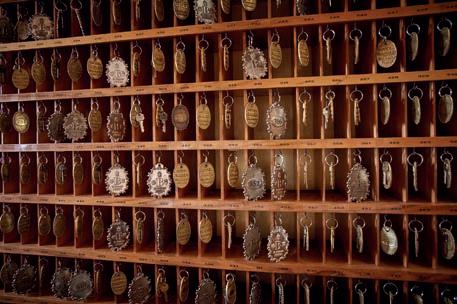
Below right Part of a tea and hot chocolate service in silver-plated metal, decorated with the monogram of the Hôtel Bauer Palazzo. e set has an estimate of €400-€500
Grünwald, an Austrian who married Bauer’s daughter. e main hotel building, facing the Grand Canal, was rebuilt from 1900 to 1902, by the Italian architect Giovanni Sardi (1863- 1913) in an eclectic neo-Gothic style. It soon became the fashionable hang out for high society. In the 1930s, the hotel underwent a period of restoration and renovation under Arnaldo Bennati, a Ligurian shipbuilder, who reshaped the hotel before its reopening in 1949. e main entrance, next to the baroque church of San Moisè, was given a modernist facade designed by the architect Marino Meo. And, for the rst time, a hotel in e Floating City was equipped with central heating and air conditioning.

of €40,000-€80,000
Below
Top Giuseppe Cesetti (1902-1990) Horses and oxen, oil on canvas. Signed and dated 1949 lower right. It has an estimate of €10,000€20,000

Above One of a set of four 19th-century coats of arms in carved, painted and gilded wood, the border decorated with cut leather and scrolls, a Venetian lion on the damping. Each has an estimate of €700-€1200
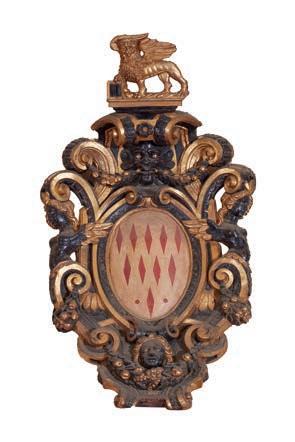
Left Much of the hotel’s dining room and table ware is up for sale

e palace boasted state-of-the-art comfort and modernity alongside old-world charm. Giuseppe Berti added another oor to the building, o ering visitors the Settimo Cielo, a terrace with a breath-taking view that remains the highest in Venice to this day.



e most important Venetian and Italian manufacturers were commissioned by the Bauer during its successive renovations.




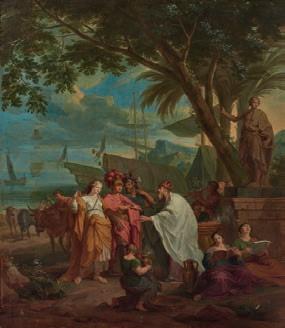
One such is the House of Rubelli which has been designing and producing silk velvets and damasks in Venice for ve generations. Other fabrics come from the House of Bevilacqua which traces its roots in the textile world to 1499. ree pairs of water-green satin curtains from the Bevilacqua factory are estimated between €4,000 and €6,000, while headboards, upholstered in Rubelli fabric are expected to fetch between €200 and €300.
e sale boasts Murano glassware, furniture and torchbearers (portes torchères). For kitchenalia collectors, there are a range of pieces from Champagne stands to plates, as well as tea and co ee sets.
e furniture on o er includes curved Venetian chests of drawers (expected to make €800-€1,000), armchairs (bergères gondoles) (estimated at €200-€600) and a trumo cabinet (meuble à deux corps) in Baroque style from one of the royal suites, which has a pre-sale guide price of €1,500-€2,000.
Below A sitting room at the Venetan hotel. A pair of velvet Venetian bergères, has an estimate of €200-€300; a pair of orange velvet two-seaters sofas has an estimate of €400-€600; three baroque style gondola-shape armchairs have an estimate of €300€600; three pairs of embroidered veiling curtains have an estimate of €100-€150 and a wooden Venetian table with marble top has an estimate of €600-€800

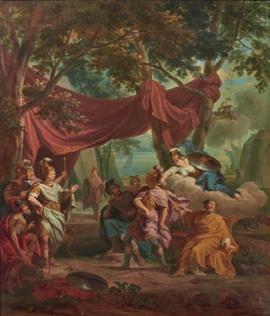
‘The most important Venetian and Italian manufacturers were commissioned by the Bauer during its successive renovations. One such is the House of Rubelli which has been designing and producing silk velvets and damasks in Venice for five generations’Above Attributed to Claudio Francesco Beaumont (Turin, 1694-1766) Chryseis returned to her father and e dispute between Achilles and Agamemnon, oil paintings on canvas. ey have an estimate e hotel front has appeated in countless lms set in the city



A gold-glazed ceramic sculpture by Grayson Perry (b. 1960) titled Alien Baby has an estimate of £5,000£7,000 as part of Sworders’ sale in Stansted Mountfitchet in Essex on April 24.

It was inspired by the Turner prizewinning artist’s visit to the neonatal ward at Broomfield Hospital in Essex and pays tribute to the “spirit of all the little lives bought into the earth by the nursing team”.
Grayson produced a range of 12 “babies” giving them to the staff in the neonatal team, as well as to the couples featured in the show. The one on sale (the 10th in the series) was a gift to the ward administrator.
A coming-ofage painting by Gazbia Sirry (1925-2021) one of the greatest Egyptian artists of her generation, is expected to make £80,000 at Sotheby’s Middle Eastern art sale on April 25.

Sirry was born in Cairo in 1925 and became known for portraying Egypt’s political and cultural changes after the country’s independence in 1922.
It is one of 80 works of art from the collection of Abdulrahman Al Zayani who, with his family, assembled artworks ranging from the historic Islamic world to contemporary international art and design.
An early 19th-century Italian, large micromosaic panel has an estimate of £5,000£7,000 at the Ripon auctioneers Elstob & Elstob’s sale on April 5. Measuring 23cm by 30cm, the finely detailed panel depicts the Temple of Vesta and is unsigned. It is mounted in an ornate gilt frame that measures 45.5cm by 53cm.
The Temple of Vesta was an ancient Roman shrine dedicated to the goddess of the hearth, the remains of which are found in the southeast of the Roman forum beside the Atrium Vestae.
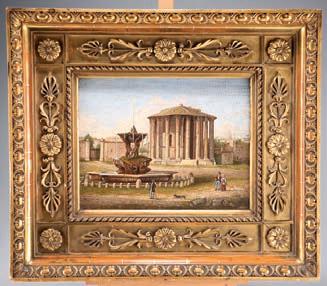
The temple also housed the Vestal virgins - the priestesses dedicated to Vesta – as well as an eternal flame, representing the everlasting nature of the Roman state. If the flame was extinguished, it forecast bad fortune for the city.
An autograph album compiled by a Kent Boy Scout of “men who did things in the Great War” has an estimate of £4,000-£6,000 at Canterbury Auction Galleries‘ two-day sale on April 1-2.
Among the signatures is a letter signed by T.E. Lawrence, better known as Lawrence of Arabia, dated November 1919 and, unusually, signed in his real name.
Lawrence hated the limelight and used pseudonyms to hide his true identity. He enlisted in the RAF under the name “John Hume Ross” and later used “Thomas Edward Shaw” – a name he used until his death, accompanied by a “TES” signature.
The album also includes signatures from Rudyard Kipling, Douglas Haig, David Lloyd George, Arthur J. Balfour, H. H. Asquith, Robert Baden Powell as well as numerous Victoria Cross recipients.
Above right e autograph book contains famous signatures of WWI heroes

A collection of 25 works by the French expressionist artist Bernard Buffet (1928-1999) goes under the hammer from Art Valorem at Hôtel Drouot on April 6.
The works, including a selection of lithographs and albums featuring his most sought-after themes, were amassed by Christine Poirot-Delpech (1933-2022) who worked at the Galerie Maurice Garnier between 1972 and 2002. During this time she established a close relationship with Buffet.
Buffet is considered one of the greatest representatives of modern French figuration and one of the most famous post-war artists. His unique and assertive style quickly propelled him to the forefront of the European art scene.
Right Bernard Bu et (1928-1999) Venice, isola di San Giorgio, 1962 has an estimate of €150,000-€220,000

A large collection of predominantly contemporary Moorcroft is part of the Shropshire auctioneer Halls’ timed sale ending on April 4.
Many of the pieces come from the 200-piece collection of Peter Richards and his wife Jean, from Criccieth in Wales, both members of the Moorcroft Collectors’ Club.
One of the most significant pieces is a large Moorcroft Woodside Farm vase (picture 3) designed by Anji Davenport –one of Moorcraft’s most sought-after painters who introduced depictions of her childhood home in 1999.



Like Davenport, Moorcroft’s painters and designers today follow in the company’s rich history. Their ability to breathe new life into their work is one of the reasons the Stoke-on-Trent factory has survived while so much of the rest of the British ceramic industry has floundered.
The factory’s founder, a Staffordshire potter named William Moorcroft, was born in 1872, and trained at what is now the Royal College of Art in London. In 1897, aged 24, Moorcroft joined pottery manufacturers James Macintyre & Co., and within a year was put in charge of the studio due to his impressive creative talent.
It was this relationship that created the highly expressive and recognisable range of Florian ware in the art nouveau style featuring Moorcroft’s trademark slip-trailing technique, called tubelining. High glazes and vibrant colours also soon became synonymous with the Moorcroft name.


Despite the eventual relationship breakdown between Moorcroft and Macintyre in 1913, Moorcroft continued in the business going on to found his factory in Stoke-on-Trent.

The factory stayed in the family when it was taken over by William’s son, Walter, after his William’s death in 1945. Queen Mary was an avid collector of Moorcroft Pottery and granted a royal warrant to William Moorcroft in 1928.
Following a difficult period during the 1980s recession, the factory was taken over and saved by Hugh Edwards and Richard Dennis. Dennis’ wife, Sally Tuffin, took over as the factory’s art director and it was her designs, several of which feature in Halls’ auction, which helped to secure Moorcroft’s future.
While most of the pieces in the collection on sale this month are small, the sale also includes a large and impressive After the Storm vase (picture 4) designed by Walter Moorcroft and dated 1998 which was produced in a limited edition of 200 pieces and stands 51.5cm high.
Halls’timedMoorcroftpotteryauction,includingthePeterand JeanRichards’collection,takesplacefromMarch24toApril4.
1A Moorcroft Rainforest vase designed by Sally Tu n, dated 1995, painted and impressed marks, 27.5cm high and boxed. It has an estimate of £150-£250. 2 A William Moorcroft Waving Corn (Windswept) vase, c. 1928-1949, of inverted form, with a dark orange ground, impressed marks including ‘Potter to the Queen’, 21cm high. It has an estimate of £200-£400. 3 A large Moorcroft Woodside Farm prestige vase designed by Anji Davenport, dated 1999 and numbered 93, signed by the designer to the base alongside further impressed and painted marks, together with the original Moorcroft retail price label, 53.5cm high, It has an estimate of £1,200-£1,800. 4 A large Moorcroft After the Storm vase dated 1998, designed by Walter Moorcroft, a limited edition numbered 121/200, signed by W. Moorcroft in blue, 51.5cm high and unboxed. It has an estimate of £600-£800. 5 A set of four Moorcroft e Seasons trial pieces, designed by DJ Hancock, dated 2000, impressed and with painted marks including designer’s signature, 9cm high and in a tted box. e set has an estimate of £180-£220. 6 A Moorcroft Meknes (At Night) pattern vase, dated 1999 designed by Beverley Wilkes. A limited-edition piece numbered 58/350, signed twice by Wilkes, painted and impressed marks, 22cm high and boxed. It has an estimate of £120-£180.



 BY SHEILA FRUMAN
BY SHEILA FRUMAN
ISBN 9781898113874
RRP £35.00


OFFER PRICE £22.75

Tells the stories of nine intrepid adventurers who combed the streets and bazaars of Central and South Asia in the postWorld War II era finding, researching, collecting and selling antique Kashmir shawls, embroidered Uzbek textiles and robes, Anatolian kilims, Turkmen carpets and many other textile treasures to interested Westerners.
ISBN 9789401487689
RRP £40.00
OFFER PRICE £26.00
Travel with nature and wildlife photographer Wouter Pattyn to explore 12 of the most beautiful nature reserves on the European continent. Along with photographs of stunning landscapes, this is a sourcebook of information for the adventurous traveller.

 BY FEDERICA RASENTI
BY FEDERICA RASENTI
ISBN 9788855210805
RRP £19.90
OFFER PRICE £12.93
This most recent guidebook in the On the Road series explores the complex urban story of Paris, one of the most densely constructed cities in Europe, through its 20th and 21st-century architecture.
 BY JOOST JOOSSEN
BY JOOST JOOSSEN
ISBN 9789460583278
RRP £20.00
OFFER PRICE £13.00
160 photography challenges that trigger your creativity and inspire you to slow down, look around, and have a more mindful outlook on life.
 BY MICHAEL L. HOROWITZ & ELIZABETH ANNE HARTMAN
BY MICHAEL L. HOROWITZ & ELIZABETH ANNE HARTMAN
ISBN 9780789214454

RRP £39.95
OFFER PRICE £25.97
An exclusive tour through the breath-taking and inspirational interiors of Manhattan’s houses of worship.
ISBN 9789401488709
RRP £45.00
OFFER PRICE £29.25

A travel guide to the 40 most luxurious and special places to stay in deserts around the world, accompanied by inspiring photographs of each location.

Because this list is compiled in advance, alterations or cancellations to the auctions listed can occur and it is not possible to notify readers of the changes. We strongly advise anyone wishing to attend an auction especially if they have to travel any distance, to telephone the organiser to confirm the details given.
LONDON: Inc. Greater London
Bonhams
101 New Bond St, London
W1S 1SR, 020 7447 7447
www.bonhams.com
Old Master Paintings, Apr 4
Hot Off the Press, Apr 19
Impressionist Jewels, Apr 20 London Jewels, Apr 26
Fine and Rare Wines, Apr 27
Bonhams
Montpelier St, Knightsbridge, London, SW7 1HH, 020 7393 3900
www.bonhams.com
Homes and Interiors, Apr 19
Knightsbridge Jewels, Apr 19
The Marine Sale, Apr 26
Chiswick Auctions
Barley Mow Centre
Chiswick, London, W4 4PH 020 8992 4442
www.chiswickauctions.co.uk
Old Masters and Fine Frames, Apr 12
Post War and Contemporary Art, Apr 18
Designer Handbags and Fashion, Mar 15
Interiors, Homes and Antiques, Apr 19
Islamic Art - Property of a European Collector Part V, Apr 28 Islamic and Indian Art, Apr 28
Christie’s
8 King St, St. James’s, SW1Y 6QT, 020 7839 9060
www.christies.com
The Collector Sale (Online), Apr 4-18
Finest and Rarest Wines and Spirits, Apr 25
Art of the Islamic and Indian Worlds Including Oriental Rugs and Carpets, Apr 27
Elmwood’s
101 Talbot Road London, W11 2AT 0207 096 8933
www.elmwoods.co.uk
Important Jewellery, Apr 4
Forum Auctions
220 Queenstown Road, London SW8 4LP, 020 7871 2640
www.forumauctions.co.uk
Books and Works on Paper (Online), Apr 13, 27
Prints and Editions (Online), Apr 13
Hansons Auctioneers
The Normansfield Theatre, 2A Langdon Park, Teddington TW11 9PS, 0207 018 9300
www.hansonsauctioneers.com
Fine Art & Collectables Auction, Apr 29
Lyon & Turnbull Mall Galleries, The Mall, St. James’s, London SW1Y 5AS, 0207 930 9115
www.lyonandturnbull.com
Lalique (Live and Online), Apr 27
Avant Garde : Art from 1900 to Now (Live and Online), Apr 27
Modern Made: Modern and Post-War Art, Design and Studio Ceramics (Live and Online), Apr 28
Noonans Mayfair
16 Bolton St, Mayfair, W1J 8BQ, 020 7016 1700
www.noonans.co.uk
Coins and Historic Medals, Apr 4-5
Orders, Decorations, Medals and Militaria, Apr 19
British Tokens, Tickets and Passes, Apr 26
Phillips 30 Berkeley Square, London, W1J 6EX, 020 7318 4010
www.phillips.com
Wired: Online Auction, Apr 12 Design, Apr 26
Casa Fornaroli, Apr 27
Roseberys Knights Hill, Norwood, London, SE27 0JD 020 8761 2522
www.roseberys.co.uk
Traditional Home (Online Only), Apr 19
Modern Home (Online Only), Apr 19
Antiquities, Islamic and Indian Arts, Apr 28
Sotheby’s New Bond St., W1A 2AA
020 7293 5000
www.sothebys.com
Mary McCartney: Can We Have a Moment? Three Decades of Photographs in Britain (Selling Exhibition), Until June 9
Important Picasso Ceramics, (Online) Apr 14-21
Testimony of a Journey: The Al Zayani Collection, Apr 25
The Orientalist Sale, Apr 25 Arts of the Islamic World and India, including Fine Rugs and Carpets, Apr 26
20th Century Art / Middle East (Online), Apr 13-27
Persepolis II (Online), Apr 13-27
TimeLine Auctions
23-24 Berkeley Square London W1J 6HE
www.timelineauctions.co.uk
020 7129 1494
None listed in April
SOUTH EAST AND EAST ANGLIA: Inc. Bedfordshire, Cambridgeshire, Essex, Hertfordshire, Kent, Norfolk, Suffolk, Surrey, Sussex
Bishop and Miller
19 Charles Industrial Estate, Stowmarket, Suffolk, IP14 5AH, 01449 673088 bishopandmillerauctions.co.uk
Maritime, Exploration and Scientific, Apr 5
Dr Automica’s Journey into Cool Music (and Musical Instruments), Apr 20
Bishop and Miller
Unit 12 Manor Farm, Glandford, Holt, Norfolk, NR25 7JP bishopandmillerauctions.co.uk
The Collector: A Carefully Curated Auction of Fine Art and Antiques, Apr 26
Bellmans Newpound, Wisborough Green, West Sussex, RH14 0AZ, 01403 700858 www.bellmans.co.uk
Wines and Spirits, Apr 17
Burstow & Hewett The Auction Gallery, Lower Lake, Battle, East Sussex,TN33 0AT, 01424 772 374
www.burstowandhewett.co.uk
Homes and Interiors, Apr 5-6
Antique Sale, Apr 27
Fine Art and Sculpture, Apr 27
The Canterbury Auction Galleries 40 Station Road West, Canterbury, Kent, CT2 8AN, 01227 763337
canterburyauctiongalleries.com
Two-Day Sale of Antiques, Apr 1-2
Catherine Southon Auctioneers Farleigh Court Golf Club, Old Farleigh Road, Selsdon, Surrey, CR6 9PE, 0208 468 1010
www.catherinesouthon.co.uk
Antiques, Apr 26
Cheffins Clifton House, Clifton Road, Cambridge, CB1 7EA 01223 213343, www.cheffins.co.uk
The Jewellery, Silver and Watches Sale, Apr 6
The Interiors Sale, Apr 20 The Library Sale, Apr 27
Ewbank’s
London Rd, Send, Woking, Surrey, 01483 223 101 www.ewbankauctions.co.uk
Vintage Posters, Apr 6
Vintage Fashion, Apr 19 Interiors and Modern Design, Apr 20
Contemporary Art, Editions and Modern British Pictures, Apr 20 Magic the Gathering: 1997-2002, Apr 21
Excalibur Auctions Limited Unit 16 Abbots Business Park Primrose Hill Kings Langley, Hertfordshire, WD4 8FR 020 3633 0913
www.excaliburauctions.com
Marvel, DC & Independent Comic Books, Apr 1
Gorringes
15 North Street, Lewes, East Sussex, BN7 2PE, 01273 472503
www.gorringes.co.uk
Antiques and General, Apr 3, 17, 24
Dolls and Doll’s Houses Sale, Apr 25
Horners the Auctioneers Old Norwich Road, Acle, Norwich, NR13 3BY 01493 750225
www.horners.co.uk
Antiques and Collectables, Apr 13
Modern and Antique Sporting Guns, Apr 15
John Nicholson’s
Longfield, Midhurst Road, Fernhurst, Haslemere, Surrey, GU27 3HA, 01428 653727
www.johnnicholsons.com
General, Apr 1
Islamic and Oriental, Apr 12 Fine Art, Apr13
Lacy Scott & Knight 10 Risbygate St, Bury St Edmunds, Suffolk, IP33 3AA, 01284 748 623
www.lskauctioncentre.co.uk
Homes and Interiors, Apr 1, 22
Toys and Models, Apr 28
Lockdales Auctioneers
52 Barrack Square, Martlesham Heath, Ipswich, Suffolk, IP5 3RF 01473 627110
www.lockdales.com
Paper Collectables (Stamps, Cards,Books and Ephemera), Apr 12
The Fine Sale, Apr 25-26
Parker Fine Art Auctions
Hawthorn House, East Street, Farnham, Surrey, GU9 7SX, 01252 203020
www.parkerfineartauctions.com
Fine Paintings, Apr 6
Reeman Dansie
8 Wyncolls Road, Severalls Business Park, Colchester, Essex, CO4 9HU, 01206 754754
www.reemandansie.com
Coins, Weapons and Militaria, Apr 5
Summers Place The Walled Garden, Billingshurst West Sussex, RH14 9AB, 01403 331331
www.summersplaceauctions.com
None listed
Sworders Fine Art Auctioneers
Cambridge Road, Stansted
Mountfitchet, Essex, CM24 8GE, 01279 817778
www.sworder.co.uk
Fine Wine and Spirits (Timed Online), ends Apr 2
Old Master, British and European Art, Apr 4
Homes and Interiors (With Wines and Spirits) (Online), Apr 18
Books and Maps (Timed Online), Apr 14-23
Modern and Contemporary Art, Apr 25
Jewellery, Designer Handbags and Accessories, Apr 26
Toovey’s Antique & Fine Art Auctioneers
Spring Gardens, Washington,
West Sussex, RH20 3BS, 01903 891955
www.tooveys.com
Asian and Islamic Ceramics and Works of Art, Apr 6 Coins, Banknotes and Medallions, Apr 18
Prints, Maps, Posters and Decorative Pictures, Silver and Plate and Jewellery, Apr 19 Arts and Crafts Furniture Metalwork and Applied Art, Apr 20
T.W. Gaze
Diss Auction Rooms, Roydon Road, Diss, Norfolk, IP22 4LN, 01379 650306.
www.twgaze.com
Blyth Barn Furniture Auction, Apr 4, 11, 18, 25
Architectural, Apr 6
Antiques and Interiors, Apr 6, 14, 21, 28
Jewellery, Apr 11 Automobilia, Apr 13
The Gallery Sale, Apr 18 Militaria, Apr 25
SOUTH WEST: Inc. Berkshire, Buckinghamshire, Cornwall, Devon, Dorset, Gloucestershire, Hampshire, Isle of Wight, Oxfordshire, Somerset, Wiltshire
Bearnes Hampton & Littlewood
St. Edmund’s Court, Okehampton Street, Exeter
EX4 1DU, O1392 41310
www.bhandl.co.uk
Spring Sale, Apr 25-26
British Bespoke Auctions
The Old Boys School, Gretton Rd, Winchcombe, Cheltenham, GL54 5EE 01242 603005
www.bespokeauctions.co.uk
Easter Automobilia, Antiques and Collectables, Apr 5
Chippenham Auction Rooms
Unit H, The Old Laundry. Ivy Road, Chippenham, Wiltshire, SN15 1SB, 01249 444544
chippenhamauctionrooms.co.uk
Enamel Signs, Shop Display, Fairground, Petroliana, Arcade Games, Vending Machines and other Early Advertising, Apr 29
Chorley’s Prinknash Abbey Park, Near Cranham, Gloucestershire, GL4 8EU, 01452 344499
www.chorleys.com
Ceramics and Glass including the Henry Sandon Study Collection, Apr 18
David Lay Auctions
Penzance Auction House , Alverton, Penzance, Cornwall 01736 361414, TR18 4RE www.davidlay.co.uk
Asian Sale, Mar 9-10
Dawsons Unit 8 Cordwallis Business Park, Clivemont Rd, Berkshire, SL6 4DP, 01628 944100 www.dawsonsauctions.co.uk
Jewellery, Watches and Silver, Apr 20
Fine Wine, Whisky, Rare Spirits and Cigars, Apr 3
Dominic Winter
Mallard House, Broadway Lane, South Cerney, Cirencester, Gloucestershire, GL7 5UQ, 01285 860006 www.dominicwinter.co.uk
Printed Books, Maps and Documents, Apr 5
Dore & Rees
Auction Salerooms, Vicarage Street, Frome, Somerset BA11 1PU, 01373 462 257 www.doreandrees.com
Automobilia, Apr 13 Select Interiors, Apr 26
Dreweatts Donnington Priory Newbury, Berkshire RG14 2JE 01635 553 553 www.dreweatts.com
Art (Online), Apr 14 Interiors (Live Online), Apr 18
Single Owner Day Sale Day 1 (Live Online), Apr 25
Single Owner Day Sale Day 2 (Live Online), Apr 26
Duke’s Brewery Square, Dorchester, Dorset, DT1 1GA, 01305 265080 www.dukes-auctions.com
Avenue Auctions, Apr 4
The Spring Auctions, Apr 5
Art and Design Post 1880, Apr 6 Interiors, Apr 20
East Bristol Auctions
Unit 1, Hanham Business Park, Memorial Road, Hanham, BS15 3JE, 0117 967 1000 www.eastbristol.co.uk
Ceramics and Collectables, Apr 8
Contemporary Art, Apr 13
Jewellery, Gold and Silver, Apr 25 Toys, Apr 27
Gardiner Houlgate
9 Leafield Way, Corsham, Wiltshire, SN13 9SW, 01225 812912
www.gardinerhoulgate.co.uk
Antiques and Vintage, Apr 27
Greenslade Taylor Hunt
The Octagon Salerooms, 113a East Reach, Taunton, Somerset TA1 3HL 01823 332525
www.gth.net
Antique and Sporting Sale, Apr 6
General Sale, Apr 20
Hansons Auctioneers
49 Parsons Street, Banbury, Oxford, OX16 5NB, 01295 817777
www.hansonsauctioneers.co.uk
Fine Art, Antiques & Collectors
Auction, Apr 1
Kinghams 10-12 Cotswold Business Village, London Road, Moreton-in-Marsh, Gloucester, GL56 0JQ, 01608 695695
www.kinghamsauctioneers.com
Fantasy and the Grotesque: A Curated Exhibition of Robert Wallace Martin and Martin Brothers, Until Apr 1
Lawrences Auctioneers Ltd Crewkerne, Somerset, TA18 8AB, 01460 703041
www.lawrences.co.uk
Books, Maps, Manuscripts and Photography, Mar 16
Mallams Oxford
Bocardo House, St Michael’s St, Oxford, OX1 2EB 01865 241358
www.mallams.co.uk
Jewellery, Watches and Silver, Apr 26-27
Mallams Cheltenham
26 Grosvenor St, Cheltenham. Gloucestershire, GL52 2SG 01242 235 712
www.mallams.co.uk
None listed for April
Mallams Abingdon
Dunmore Court, Wootten Road, Abingdon, OX13 6BH, 01235 462840
www.mallams.co.uk
The House and Garden Sale, Apr 3
Moore Allen & Innocent Burford Road Cirencester, Gloucestershire GL7 5RH, 01285 646050
www.mooreallen.co.uk
Vintage and Antique Furniture and Home Interiors (Live Online),
Because this list is compiled in advance, alterations or cancellations to the auctions listed can occur and it is not possible to notify readers of the changes. We strongly advise anyone wishing to attend an auction especially if they have to travel any distance, to telephone the organiser to confirm the details given.
Apr 5 and 6
Vintage and Antique Furniture and Home Interiors (Timed Online) Apr 7-12
Philip Serrell
Barnards Green Rd, Malvern, Worcestershire.
WR14 3LW, 01684 892314
www.serrell.com
Interiors, Apr 6 and 27
Stroud Auctions
Bath Rd, Trading Est, Bath Rd, Stroud, Gloucestershire, GL5 3QF 01453 873 800
www.stroudauctions.co.uk
Toys, Vinyl Records, Musical Instruments, Pictures, Books, Ephemera and Stamps, Apr 12-13
Special Auction Services
Plenty Close, Newbury, Berkshire, RG14 5RL 01635 580 595 wwwspecialauctionservices.
Antiques and Collectables, Apr 4
Dolls and Teddy Bears, Apr 13
Photographica and Cameras
Auction, Apr 18
Glorious Trains Auction (Part 1) Apr 25
The Cotswold Auction Company
Bankside saleroom Love Lane, Cirencester, Gloucestershire, GL7 1YG, 01285 642420
www.cotswoldauction.co.uk
Silver, Jewellery, Asian, Antiques and Interiors, Apr 4-5
The Cotswold Auction Company Chapel Walk saleroom, Chapel Walk Cheltenham, Gloucesterhire, GL50 3DS, 01242 256363
www.cotswoldauction.co.uk
None listed in April
The Pedestal
The Dairy, Stonor Park, Henley-on-Thames, Oxfordshire RG9 6HF, 01491 522733
www.thepedestal.com
Antiques (Timed, Online)
Until Apr 2
Wessex Auction Rooms
Westbrook Far, Draycot Cerne Chippenham, Wiltshire, SN15 5LH, 01249 720888
www.wessexauctionrooms.co.uk
Antiques and Collectables (with BBC Bargain Hunt), Apr 1
Militaria, Apr 6
Antiques, Collectables and Furniture Apr 15, 29
Vinyl Records and Music Memorabilia, Apr 20-21
Woolley & Wallis 51-61 Castle Street, Salisbury, Wiltshire, SP1 3SU, 01722 424500
www.woolleyandwallis.co.uk
Furniture, Works of Art and Clocks, Apr 4-5
Silver and Object of Vertu, Apr 18-19
Fine Jewellery, Apr 20-21
British and Continental Ceramics and Glass, Apr 26
Wotton Auction Rooms
Tabernacle Road
Wotton-under-Edge, Gloucestershire, GL12 7EB, 01453 708260
www.wottonauctionrooms.co.uk
April Antiques Sale, Apr 17-19
EAST MIDLANDS: Inc. Derbyshire, Leicestershire, Lincolnshire, Northamptonshire, Nottinghamshire, Sheffield
Bamfords The Derby Auction House, Chequers Road, Derby, DE21 6EN, 01332 210 000
www.bamfords-auctions.co.uk
Antiques and Interiors, Apr 12
Three-Day Fine Art and Antique Auction, Apr 26-28
Bamfords
The Bakewell Auction House Peak Shopping Village Chatsworth Road Rowsley DE4 2JE, 01629 730 920
www.bamfords-auctions.co.uk
The Gallery Sale - Modern Paintings and Limited Prints, Apr 27
Batemans
Ryhall Rd, Stamford, Lincolnshire, PE9 1XF, 01780 766 466
www.batemans.com
Antiques & Specialist Collectors, Apr 29
Gildings Auctioneers
The Mill, Great Bowden Road, Market Harborough, LE16 7DE
01858 410414
www.gildings.co.uk
Antiques and Collectors’, Apr 4
Fine Art and Antiques, Apr 18
Jewellery and Watches, Apr 25
Golding Young & Mawer
The Bourne Auction Rooms, Spalding Road, Bourne, Lincolnshire PE10 9LE 01778 422686
www.goldingyoung.com
Bourne Collective Sale, Apr 12-13
Bourne Toy, Transport & Automobilia Sale, Apr 26
Golding Young & Mawer
The Grantham Auction Rooms, Old Wharf Road, Grantham, Lincolnshire NG31 7AA, 01476 565118
www.goldingyoung.com
Grantham Collective Sale, Apr 5-6
Golding Young & Mawer
The Lincoln Auction Rooms, Thos Mawer House, Station Road North Hykeham, Lincoln LN6 3QY, 01522 524984
www.goldingyoung.com
Lincoln Collective Sale, Apr 19-20
Hansons Heage Lane, Etwall, Derbyshire, DE65 6LS 01283 733988
www.hansonsauctioneers.co.uk
Antique & Collectors Auction, Apr 13
Specialist Toys, Models, Live Steam & Video Game Auction, Apr 28
WEST MIDLANDS: Inc.
Birmingham, Coventry, Herefordshire, Shropshire, Staffordshire, Warwickshire
Cuttlestones Ltd
Wolverhampton Auction Rooms, No 1 Clarence Street, Wolverhampton, West Midlands, WV1 4JL, 01902 421985
www.cuttlestones.co.uk
None listed in April
Cuttlestones Ltd
Pinfold Lane, Penkridge Staffordshire
ST19 5AP, 01785 714905
www.cuttlestones.co.uk
Antiques and Interiors, Apr 6, 20
Fellows
Augusta House, 19 Augusta Street, Hockley, Birmingham, B18 6JA 0121 2122131
www.fellows.co.uk
Jewellery Day 1, Apr 4
Jewellery Day 2, Apr 5
Pawnbrokers, Jewellery and Watches, Apr 6, 20
Watches and Watch Accessories, Apr 6
Fine Jewellery, Apr 13
The Gemstone Sale, Apr 20
Jewellery and CostumeJewellery
Day 1, Apr 25
Jewellery and CostumeJewellery
Day 2, Apr 26
Bags of Costume Jewellery, Apr 27
Fieldings Mill Race Lane, Stourbridge, DY8 1JN 01384 444140
www.fieldingsauctioneers.co.uk
Antiques and Interiors, Apr 20-21
Halls
Bowmen Way, Battlefield, Shrewsbury, Shropshire, SY4 3DR 01743 450700
www.hallsgb.com/fine-art.com
Moorcroft Pottery (Timed), Mar 24 to April 4
Modern and Contemporary Art (Timed), Apr 21 to May 7
Hansons Auctioneers
Bishton Hall, Wolseley Bridge, Stafford, ST18 0XN, 0208 9797954
www.hansonsauctioneers.co.uk
Toys & Railwayana Auction, Apr 5
Country House Attic & General Auction, Apr 15
Whisky & Spirits Auction, Apr 26
Travel & Transport Auction: To Include Titanic & Concorde Memorabilia, Apr 27
Trevanion
The Joyce Building, Station Rd, Whitchurch, Shropshire, SY13 1RD, 01928 800 202
www.trevanion.com
Fine Art and Antiques, Apr 26
NORTH: Inc. Cheshire, Co.
Durham, Cumbria, Humberside, Lancashire, Greater Manchester, Northumberland, Tyne & Wear, Sheffield, Yorkshire
Adam Partridge Withyfold Drive, Macclesfield, Cheshire, SK10 2BD 01625 431788
www.adampartridge.co.uk
Jewellery, Silver, Coins, Watches and Boutique, Apr 12-14
Adam Partridge The Liverpool Saleroom, 18 Jordan Street, Liverpool, L1 OBP 01625 431788
www.adampartridge.co.uk
Maritime and Militaria with Antiques & Collectors’ Items, Apr 5-6
Anderson and Garland
Crispin Court, Newbiggin Lane, Westerhope, Newcastle upon Tyne, NE5 1BF, 0191 4321911
www.andersonandgarland.com
The Music Auction, Mar 1
Homes and Interiors, Mar 7
Fine Silver, Jewellery and Watches, Mar 21
Spring Country House and Fine Interiors, Mar 21-23
Capes Dunn The Auction Galleries, 40 Station Road, Heaton Mersey, SK4 3QT. 0161 2731911
www.capesdunn.com
Interiors, Vintage and Modern Furniture, Apr 3, 17
Jewellery, Silver, Watches and Gold Coins, Apr 4
Northern Artists and Modern Art, Apr 20
David Duggleby Auctioneers
The Gallery Saleroom, Scarborough, North Yorkshire, YO11 1XN, 01723 507111
www.davidduggleby.com
Affordable Art, Apr 1, 22
The Furnishing Sale - Furniture, Interiors and Clocks, Apr 1, 22
Jewellery and Watches, Apr 13
The Silver Sale, Apr 20
Decorative Antiques and Collectors, Apr 21
Collectors and Clearance, Apr 21 Toys and Models, Apr 28
Duggleby Stephenson
The Saleroom, York Auction Centre, Murton, York
YO19 5GF,01904 393300
www.dugglebystephenson.com
Jewellery and Watches, Apr 13
Elstob & Elstob Ripon Business
Park, Charter Road, Ripon, North Yorkshire HG4 1AJ, 01677 333003
www.elstobandelstob.co.uk
Antiques, Apr 5
Jewellery and Watches, Apr 26
Pictures, Apr 24 to May 7
Omega Auctions Ltd
Sankey Valley Industrial Estate, Newton-Le-Willows, Merseyside WA12 8DN, 01925 873040
www.omegaauctions.co.uk
Day 1: Audio Equipment and Music Memorabilia, Apr 25
Day 2: Rare and Collectable Vinyl Records, Apr 26
Sheffield Auction Gallery
Windsor Road, Heeley, Sheffield, S8 8UB, 0114 2816161
www.sheffieldauctiongallery.com
Specialist Collectable Toys, Apr 13 Silver, Jewellery and Watches, Apr 13, 27
Antiques and Collectables, Apr 14, 28
Model Railway, Apr 27
Shelby’s Auctioneers Ltd Unit 1B Westfield House, Leeds LS13 3HA, 0113 2502626
www.shelbysauctioneers.net
Antiques and General Sale, (Online) Apr 4, 18
Tennants Auctioneers
The Auction Centre, Harmby Road, Leyburn, North Yorkshire
DL8 5SG, 01969 623780
www.tennants.co.uk
Toys and Models, Sporting and Fishing, Apr 5
Antiques and Interiors, to include Beswick and Border Fine Arts, Apr 6
Natural History and Taxidermy, Apr 19
Antiques and Interiors, Apr 21
Fine Wine and Whisky, Apr 21 Books, Maps and Manuscripts, Apr 28
Thomson Roddick
The Auction Centre, Marconi Road, Burgh Road Industrial Estate, Carlisle, Cumbria, CA2 7NA, 01228 535288
www.thomsonroddick.com
Home Furnishings and Interiors
Auction Including Jewellery, Silver, Paintings, Porcelain, Collectables, Furniture etc, Apr 11
Vectis Auctions Ltd
Fleck Way, Thornaby, Stockton on Tees, TS17 9JZ,
01642 750616
www.vectis.co.uk
Doll and Teddy Bear Sale, Apr 5
Specialist Diecast Sale, Apr 12-13
General Toy Sale, Apr 20 Model Train Sale, Apr 21
TV and Film-Related Sale, Apr 25-26
Action Man and Lego Sale, Apr 27
Warren and Wignall
The Mill, Earnshaw Bridge, Leyland Lane, Leyland, Lancashire, PR26 8PH 01772 369884
www.warrenandwignall.co.uk
General Antiques and Interiors, Apr 5
Collectors Sale including Coins, Silver and Costume Jewellery etc. Apr 12
Collectors Sale including Musical Instruments, Cameras, Records and Toys etc. Apr 26
Wilkinson’s Auctioneers
The Old Salesroom, 28 Netherhall Road, Doncaster, South Yorkshire, DN1 2PW, 01302 814 884 wilkinsons-auctioneers.co.uk Decorative Sale, Apr 23
Wilson55
Victoria Gallery, Market St, Nantwich, Cheshire CW5 5DG 01270 623 878 www.wilson55.com
Fine and Classic, Apr 6 Modern Interior & Collectables Apr 20
Sporting Memorabilia, Apr 27
Bonhams
22 Queen St, Edinburgh, EH2 1JX 0131 225 2266
www.bonhams.com
Folk Art, Naïve Paintings and Vernacular Furniture, Apr 18
Lyon & Turnbull
33 Broughton Place, Edinburgh. EH1 3RR, 0131 557 8844
www.lyonandturnbull.com
Contemporary and Post-War Art Prints and Multiples, Apr 4 Design Since 1860, Apr 19
McTears Auctioneers
31 Meiklewood Road, Glasgow, G51 4GB, 0141 810 2880 www.mctears.co.uk
Coins and Banknotes, Apr 6
Jewellery, Apr 6, 28
Watches, Apr 6
Antiques and Interiors, Apr 7, 21
The Scottish Contemporary Art Auction, Apr 13
Whisky, Apr 14
Militaria, Maps and Ethnographica, Apr 26
British and International Pictures, Apr 26
Clocks and Instruments, Apr 27
Fine Furniture and Works of Art, Apr 27
Toys, Models and Pop Culture, Apr 27
Sporting Medals and Trophies, Apr 28
Thomson Roddick The Auction Centre, 118 Carnethie Street, Edinburgh, EH24 9AL 0131 440 2448
www.thompsonroddick.com
None listed in April
WALES
Anthemion Auctions
15 Norwich Road, Cardiff, CF23 9AB. , 029 2047 2444
www.anthemionauction.com
General Sale, Apr 5
Jones & Llewelyn
Unit B, Beechwood Trading Estate, Llandeilo, , Carmarthenshire, SA19 7HR, 01558 823 430 www.jonesandllewelyn.com
General Sale, Apr 8, 22
Rogers Jones & Co
17 Llandough Trading Estate, Penarth, Cardiff, CF11 8RR, 02920 708125
www.rogersjones.co.uk
The Welsh Sale, Apr 1 Selections and Collections, Apr 1 Fine Art and Interiors, Apr 14
IRELAND
Adam’s
26, Stephens Green, Dublin 2, D02 X665, Ireland 00 353 1 6760261
www.adams.ie
None listed in April
Whyte’s
38 Molesworth St. Dublin D02 KF80 Ireland, 00 353 1 676 2888
www.whytes.ie
Spring Art (Online) Apr 3
Eclectic Collector, Apr 22



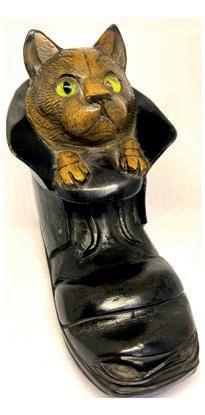

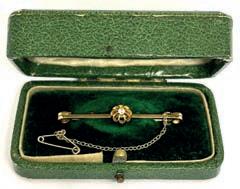

Vintage fashion, antique textiles and costumes from around the world will be on show and sale at the Antique and Vintage Textile Fair, Manchester on April 23

Collectors will find textiles from the 18th century to the 1970s with a number of dealers specialising in mid-century textiles, including Retropattern which will be bringing textiles from Heals, Liberty, David Whitehead and Hull Traders.
In addition to the fair, the event offers an insight into textile practices, supported by guilds, museums and archives. There are free talks throughout the day, discussing textiles and design topics.
London Original Print Fair (LOPF), London’s longest running art fair, returns to Somerset House for its 38th edition this month.

Founded in 1985, LOPF celebrates printmaking in all its forms, from old masters to contemporary art, with major works promised by Tracey Emin, Grayson Perry, Harland Miller and Gavin Turk.
Director of the fair, which runs from March 30 to April 2, Helen Rosslyn, said: “We are delighted to welcome several new exhibitors this year, which suggests that even in these uncertain times the print world is alive and well.” New exhibitor, Muban Educational Trust, will join existing exhibitor Art China in celebrating contemporary Chinese woodblocks.
For the fourth year, Tribal Art Fair is holding an online edition this month bringing together pieces from Africa, Oceania, Asia and the Americas.

Set to take place at www.tribalartfair.nl/ onlinefair from April 26 to May 1, the virtual event brings together 20 galleries, from the UK, Holland, Spain, Germany, France, Thailand, Austria and Belgium.
Each dealer will showcase up to 50 of their latest acquisitions, with a stock refresh of 10 pieces per vendor scheduled for April 29.
As well as selling authentic masks, shields, statues, textiles, jewellery and utensils, TAF is renowned for hosting an inspiring lecture programme, which can of course also be followed online.
Hot on the heels of the cancellation of both Masterpiece London and the summer edition of the Art & Antiques Fair Olympia, this month’s The Open Art Fair (TOAF) has been scrapped due to lack of interest.
But, in better news, LAPADA announced its fair will return to its Berkeley Square location from September 27 to October 1, for the first time being open to non-member dealers.
TOAF organiser, Thomas Woodham-Smith, said: “With great regret we have to report that there is not sufficient interest from exhibitors to justify The Open Art Fair this year, in spite of many committed dealers whose enthusiasm should not be undervalued.”

The fair, which in part replaced the British Antiques Dealers’ Association (BADA) spring fair, had been due to take place from April 19-23 at the Duke of York Square, Chelsea.

While another London fair cancels this month, there is still plenty going on online and around the countryAbove e event in Manchester showcases some of the UK’s nest specialists
Because this list is compiled in advance, alterations or cancellations to the fairs listed can occur and it is not possible to notify readers of the changes. We strongly advise anyone wishing to attend a fair, especially if they have to travel any distance, to telephone the organiser to confirm the details given.
LONDON: Inc. Greater London
Adams Antiques Fairs
020 7254 4054
www.adamsantiquesfairs.com
Adams Antiques Fair, The Royal Horticultural Halls, Elverton Street, SW1P 2QW, Apr 23
Etc Fairs, 01707 872 140 www.etcfairs.com
Turner Suite at Holiday Inn, Coram Street, London, WC1N 1HT, Bloomsbury Book Fair
Apr 16
London Original Print Fair 07805 679275
www.londonoriginalprintfair.com
Somerset House, Strand London, WC2R 1LA
March 30 to April 2
Sunbury Antiques
01932 230946
www.sunburyantiques.com
Kempton Antiques Market, Kempton Park Race Course, Staines Road East, Sunbury-on-Thames, Middlesex TW16 5AQ, Apr 11, 25
SOUTH EAST & EAST ANGLIA: including Beds, Cambs, Essex, Hertfordshire, Kent, Norfolk, Suffolk, Surrey, Sussex.
Arun Fairs 07563 589725
Rustington Antiques & Collectables Fair, The Woodland Centre, Woodlands Avenue, Rustington West Sussex, BN16 3HB, Apr 2
B2B Events
07774 147197 or 07771 725302
www.b2bevents.info
Detling Antiques, Vintage & Collectors Fair, Kent County
Showground, Detling, Nr
Maidstone ME14 3JF, Apr 22-23
Continiuity Fairs
01584 873634
www.continuityfairs.co.uk
Antique Fair, Epsom Downs Racecourse
Tattenham Corner Rd, Epsom KT18 5LQ, Apr 4
Dovehouse Fine Antiques Fair
07952689717
dovehousefineantiquesfairs.com
Dorking Halls, Reigate Road, Dorking, Surrey, RH4 1SG, Apr 30
Grandmas Attic Antique and Collectors Fairs
www.grandmasatticfairs.co.uk
The Grange Centre, Bepton Road, Midhurst, GU29 9HD, Apr 2
IACF, 01636 702326
www.iacf.co.uk
Ardingly International Antiques & Collectors Fair, South of England Showground, Ardingly, Nr Haywards Heath, West Sussex, RH17 6TL, Apr 18-19
Peterborough Festival of Antiques, The East of England Showground, Peterborough, Cambridgeshire, PE2 6HE, Apr 7-8
Redbourn Antiques Fair, Hertfordshire County Showground, Redbourn, Hertfordshire AL3 7PT, Apr 24
Love Fairs 01293 690777
www.lovefairs.com
Lingfield Park Racecourse, Racecourse Road, Lingfield. Surrey. RH7 6PQ, Apr 2
Marcel Fairs 07887648255
www.marcelfairs.co.uk
Antique and Collectors Fair, Sarratt Village Hall, The Green, Rickmansworth, Herts WD3 6AS, Apr 9
Antique and Vintage Fair –Eagle Farm Road, Biggleswade, Bedfordshire, SG18 8JH, Apr 16
SOUTH WEST including Berkshire, Buckinghamshire, Cornwall, Devon, Dorset, Gloucestershire, Hampshire, Isle of Wight, Oxfordshire, Somerset, Wiltshire.
AFC Fairs
07887 753956
www.antiquefairscornwall.co.uk
Lostwithiel Antique & Collectors
Fair, Lostwithiel Community
Centre, Pleyber Christ Way, Lostwithiel, Cornwall, PL22 0HE, Apr 9
Pensilva Antiques Fair, Millennium House, Princess Road, Liskeard, Cornwall, PL14 5NF, Apr 30
Arun Fairs 07563 589725
Emsworth Antiques and Collectors Fair, Emsworth Community Centre., North Street, Emsworth, Hampshire, PO10 7DD, Apr 9
Continiuity Fairs
01584 873634
www.continuityfairs.co.uk
Royal Welsh Showground, Llanelwedd, Builth Wells LD2 3NJ, Apr 29-30
Matford Centre, Matford Park Rd, Marsh Barton, Exeter EX2 8FD, Apr 8
Cooper Events 01278 784912
The Cotswolds
www.cooperevents.com Antiques, Decorative and Art Fair, Westonbirt School, Tetbury, South Cotswolds, Gloucestershire, GL8 8QG, March 31 to April 2
Grandma’s Attic Antique and Collectors Fairs
www.grandmasatticfairs.co.uk
Allendale Centre, Hanham Road, Wimborne, BH21 1AS, Apr 10 Places Leisure, Fleming Park, Passfield Avenue, Eastleigh, SO50 9NL, Apr 10
Jay Fairs, 01235 815633
Benson Antiques and Collectors Fair, Benson Parish Hall, Sunnyside, Benson, Nr. Wallingford, Oxfordshire, OX10 6LZ, Apr 16
EAST MIDLANDS including Derbyshire, Leicestershire, Lincolnshire, Northamptonshire, Nottinghamshire, Rutland.
Arthur Swallow Fairs
01298 274493
Vintage Flea Market, EXO Centre, Lincoln Showground, Lincoln LN2 2NA, Apr 2
Antiques & Salvage Market
Clay House Farm, Tabley, Knutsford, WA16 0HJ, Apr 22
Navenby Antiques and Collectors Fair at The Venue, 07522 679 630
Venue at Navenby, Grantham Road, Navenby, Lincolnshire, LN5 0JJ, Apr 9
Stags Head Events
07583 410862
www.stagsheadevents.co.uk
Bank Holiday Antiques & Vintage Fair, Hood Park Leisure Centre, Ashby-de-la-Zouch, LE65 1LS, Apr 10
Antiques & Vintage Fair
Brockington Campus
Enderby, Leicestershire, LE19 4AQ, Apr 30
WEST MIDLANDS including Birmingham, Coventry, Herefordshire, Shropshire, Staffordshire, Warwickshire, Worcestershire
B2B Events 07774 147197 or 07771 725302
www.b2bevents.info
Malvern Flea & Collectors Fair
Three Counties Showground, Malvern, Worcestershire, WR13 6NW, Apr 10
Nuneaton Antiques and Flea Market
01827 895899
U.R.C Hall, Chapel Street (off Coventry St.), Nuneaton, Warwickshire, CV11 5QH Apr 8
NORTH including Cheshire, Cumbria, Lancashire, Northumberland, Tyne and Wear, Yorkshire.
V&A Fairs 01244 659887 www.vandafairs.com
Civic Hall Nantwich Beam Street, Nantwich, Cheshire England, CW5 5DG, Apr 20
SCOTLAND
Glasgow, Antique, Vintage & Collectors Fair 07960 198409, Bellahouston Leisure Centre, 31 Bellahouston Drive, Glasgow, G52 1HH, Apr 16
Kelso Antique Fleamarket Fair, 07760 660556
BUAS Showground, Springwood Park, Kelso, TD5 8LS, Apr 8-9
IRELAND
Dun Laoghaire Antiques & Collectors Fair, 00353 85 862 9007
Royal Marine Hotel, Marine Road Dun Laoghaire, Apr 2

Labelled/ stamped branded furniture from Georgian to Victorian, eg Thomas Butler, Morgan & Sanders, J Alderman, Ross of Dublin (pictured), Gregory Kane, Wilkinson of Ludgate Hill, Robert James of Bristol, James Winter, W Priest, Samuel Pratt and many others. Tables all types, chairs, bookcases, , Davenport. mirrors etc. Campaign shower.

1 The Square, Church Street, Edenbridge, Kent TN8 5BD
01732 865 988 or 07836233473 cato@lennoxcato.com

www.lennoxcato.com


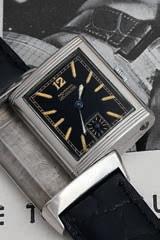
Omega Seamasters and pre-1980s Omegas in general.
IWC and Jaeger LeCoultres, all styles. Looking for Reversos. American market filled and 14k pieces possibly, at the right price.
Omega Seamasters and pre-1980s Omegas in general. IWC and Jaeger LeCoultres, all styles. Looking for Reversos. American market filled and 14k pieces possibly, at the right price.
Breitling Top Times, Datoras and 806 Navitimers.
Pre-1960s Rolex models, with a focus in pre-war tanks, tonneaus etc. Gold or silver/steel. Also World War I Rolex 13 lignes etc. Princes.

Breitling Top Times, Datoras and 806 Navitimers. Pre-1960s Rolex models, with a focus in pre-war tanks, tonneaus etc. Gold or silver/steel. Also World War I Rolex 13 lignes etc. Princes.


Longines, Tudors and Zeniths, pre-1970. Even basic steel models in nice condition. All the quirky oddities like Harwoods, Autorists, Wig Wag, Rolls etc, and World War I hunter and semi-hunter wristwatches.
Longines, Tudors and Zeniths, pre-1970. Even basic steel models in nice condition. All the quirky oddities like Harwoods, Autorists, Wig Wag, Rolls etc, and World War I hunter and semi-hunter wristwatches.
Early, pre-war ladies’ watches also wanted by Rolex, Jaeger LeCoultre etc. Prefer 1920s/30s deco styles, but early doughnuts also considered.
Early, pre-war ladies’ watches also wanted by Rolex, Jaeger LeCoultre etc. Prefer 1920s/30s deco styles, but early doughnuts also considered.
Yorkshire based, but often in London and can easily collect nationwide.
Yorkshire based, but often in London and can easily collect nationwide.
vintagejewellery@yahoo.co.uk or tel 07958 333442
Signed and unusual furniture. Georgian, Regency, William IV. Sofa / Pembroke / side tables, library furniture / bookcases. Also Victorian campaign chests, armchairs etc. Ross of Dublin, Morgan & Sanders, Williams & Gibton, James Winter, Hill & Millard and many others.
Georgian chamber horse exercise chair (pictured)

Unusual Georgian to William IV architectural features eg doors, door frames, over door pediments. 18th century staircase spindles and handrail needed. Anything Georgian or Regency with lots of character considered.
J Alderman. Daws and George Minter reclining chairs. Shoolbred/ Hamptons / Cornelius Smith Victorian armchairs.

Marble fire surrounds. Georgian / Regency/ William IV. Bullseyes etc. Exceptional Georgian / Regency fire grates
Rectangular Georgian fanlight.
Sash windows x 4 identical. Georgian reclaimed. Approx 58” high x 36” wide. Wide reclaimed floorboards. Approx 100 m2. Early decorative oil / gas / electric light fittings. Ceiling, wall or table. Early gasoliers. Colza lamps. Gimble lamp.
Four identical reclaimed Georgian wooden sash windows with boxes, approx 60 high x 37 wide.
Roland Ward, Van Ingen taxidermy. Human skull. Hippopotamus skull. Stuffed crocodile / alligator.
Marble fire surrounds from 1750 to 1850ish. White or coloured. Bullseyes, William IV styles etc. Brass Regency reeded fire insert and Victorian griffin grate (pictured)


Quirky architectural features. Regency columns, corbels, marble and stone pieces, over door pediments, folding/rolling multi part Georgian room dividing doors.
Human skull, stuffed crocodile/ alligator. Grand tour souvenirs.
Victorian canopy shower bath. Decorated toilets etc Unitas, Simplicitas, Deluge etc. Decorated basins x 3.

PM Antiques & Collectables are a modern and innovative antiques retailer based in Surrey. Specialising in a wide array of collector’s items, including contemporary art, entertainment and memorabilia, vintage toys, decorative ceramics, watches and automobilia.



Ilove lecturing. Few people have the pleasure of being invited to venues around the world to talk about subjects for which they have a great passion and interest and get paid for it. As I write this, my case is open on the bed ready in preparation of another trip. I’m actually fretting more about my capsule wardrobe requirements for an upcoming nine-lecture tour of New Zealand, than I am about the talks themselves. I’ll be gone for three and half weeks and the build up to it has been quite stressful at times, mainly due to the complicated travel arrangements and visa requirements. However, I know it’ll be worth it and to be honest, the lectures are the relatively easy bit. e less easy part is often the Q&A session afterwards.
Don’t get me wrong, I enjoy the challenge of some searching post-lecture interrogation. Some questions can be controversial while others are very light-hearted. Most puzzling, however, is the fact very few of them have anything to do with the lecture I have just given.
So what are the main subjects that arise? Well, if I’d kept a record of them over the years, the top question would be: “Who does the dusting in your house?”

Being forearmed is very helpful and, in this instance, I usually quote Quentin Crisp who said: “ ere is no need to do any housework at all. After the rst four years, the dirt doesn’t get any worse.” is always elicits a laugh before I go on to explain my rather Virgoan tendencies to methodically do the rooms on a rota, often using a sable
brush to remove the dust from the intricate lacquered iron plates of my suit of Samurai armour.
Other questions invariably involve working on the Antiques Roadshow and, the inevitable: “What’s Fiona (Bruce) like?” Almost as if they expect me to spill some tabloid-worthy gossip about her. Of course, I have nothing but the highest regard for Fiona and greatly enjoy working with her.
I’m also frequently asked about the demise of brown furniture and my views on upcycling. I point out that I work in a very green industry, with most days devoted to recycling people’s possessions. I then ramble on about the bene ts of buying good-quality Georgian and Victorian furniture and my dislike for the expression “brown furniture”, a phrase which never does it justice in my eyes.
One more original question that popped up recently was on whether Ikea had invented the at-pack. I loved that one and went into a protracted history of furniture deconstruction through the ages.
But of all the things I most get asked about there is always one on which I try to stay rmly on the fence e question of whether we should return the Elgin Marbles always sparks a spirited debate on the oor. After considering the contextual circumstances of their acquisition, I generally wrap up with a politician-worthy, uncontentious, “We’ll have to wait and see.”
So what questions might New Zealand bring? Well, we’ll have to wait and see.
Marc Allum is an author, lecturer and specialist on the BBC’s Antiques Roadshow, for more details go to www.marcallum.co.uk

Above Marc prefers to stay tight-lipped on the thorny question of the Elgin Marbles, image Shutterstock

Right Antiques Roadshow host Fiona Bruce also excites the audiences, image Richard Ginger

‘Other questions invariably involve working on the AntiquesRoadshow and the inevitable: “What’s Fiona (Bruce) like?” Almost as if they expect me to spill some tabloid-worthy gossip about her’
Fiona Bruce, dusting and the Elgin Marbles are all topics Antiques Roadshow expert Marc Allum has to tackle on the lecture circuit

















































acarefullycuratedauctionofFineArt&Antiques
onWednesday26April2023startingat10amatourGlandfordAuctionGallery
AfineWilliam&Maryoysterveneeredcabinetonstand. estimate:£4,000-£6,000

viewing: youcanviewthisauctionatourGlandfordAuctionGallery,12ManorFarm,Glandford, NR257JPonMonday24April2023andTuesday25April2023between9.30amand4.30pm andonthemorningoftheauctionfrom9am.Fullauctiondetailswillbeavailableonourwebsite.
www.bishopandmillerauctions.co.uk
GlandfordAuctionGallery:12ManorFarm,Glandford,nrHolt,Norfolk,NR257JP norfolk.enquiries@bm-auctions.co.uk01263687342
Stowmarketsaleroom:19CharlesIndustrialEstate,Stowmarket,Suffolk,IP145AH enquiries@bm-auctions.co.uk01449673088